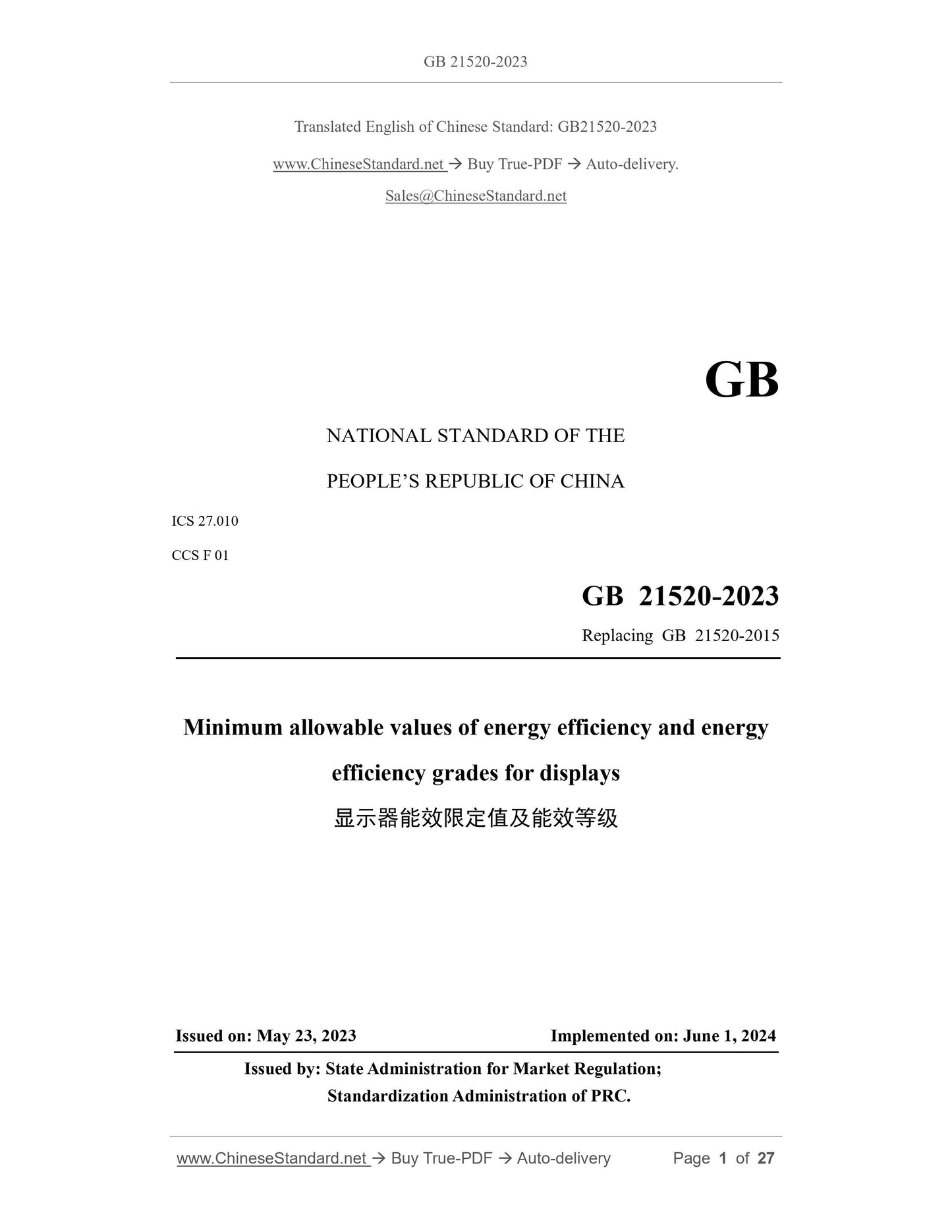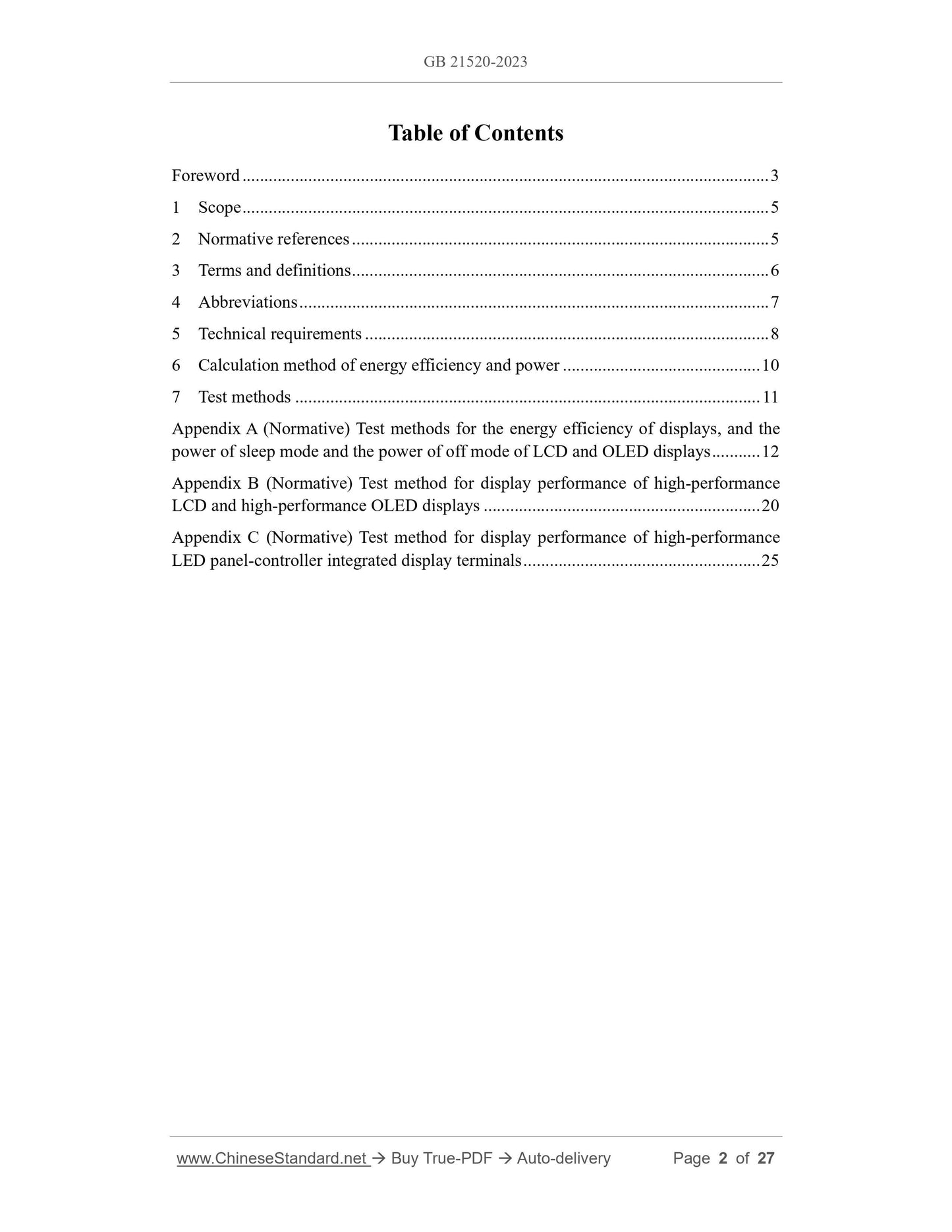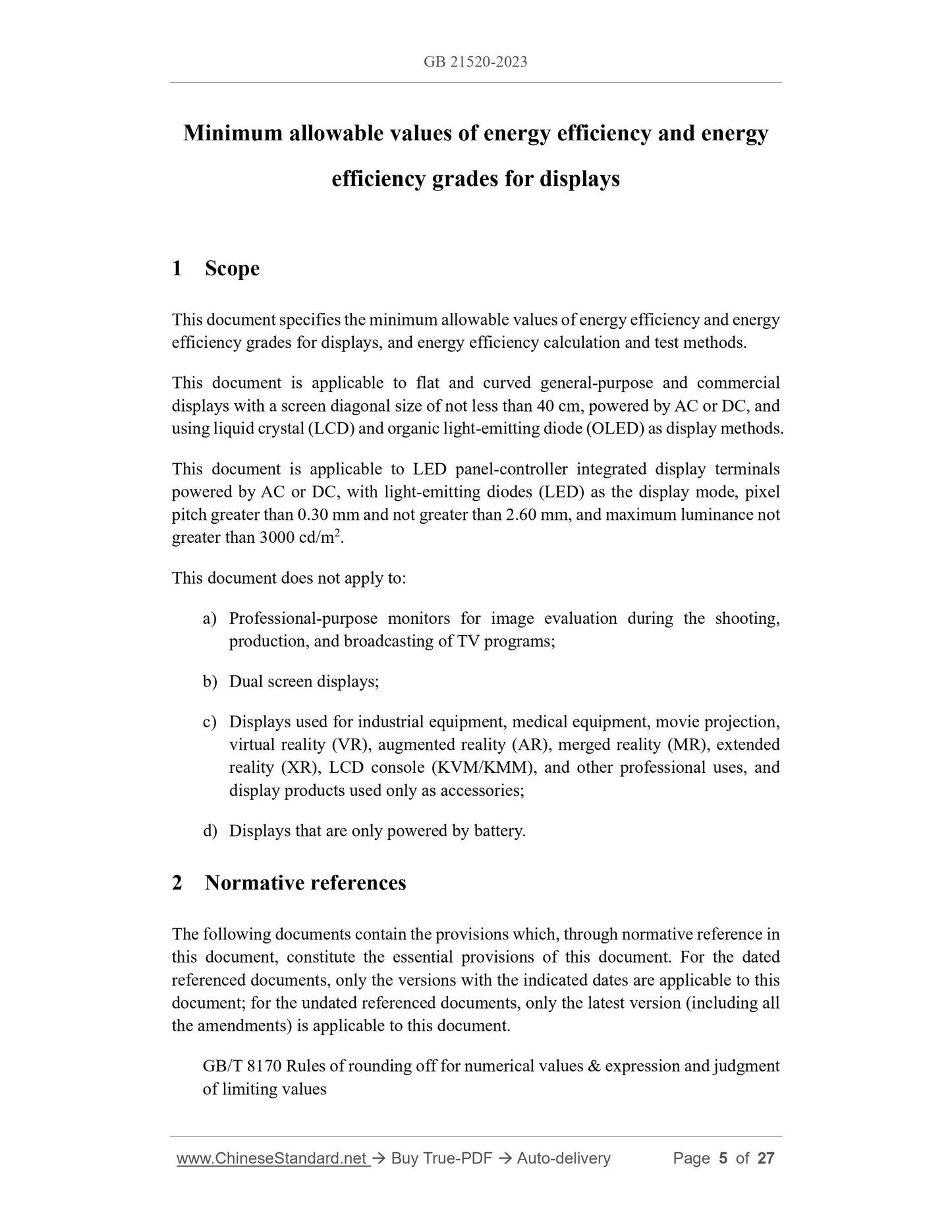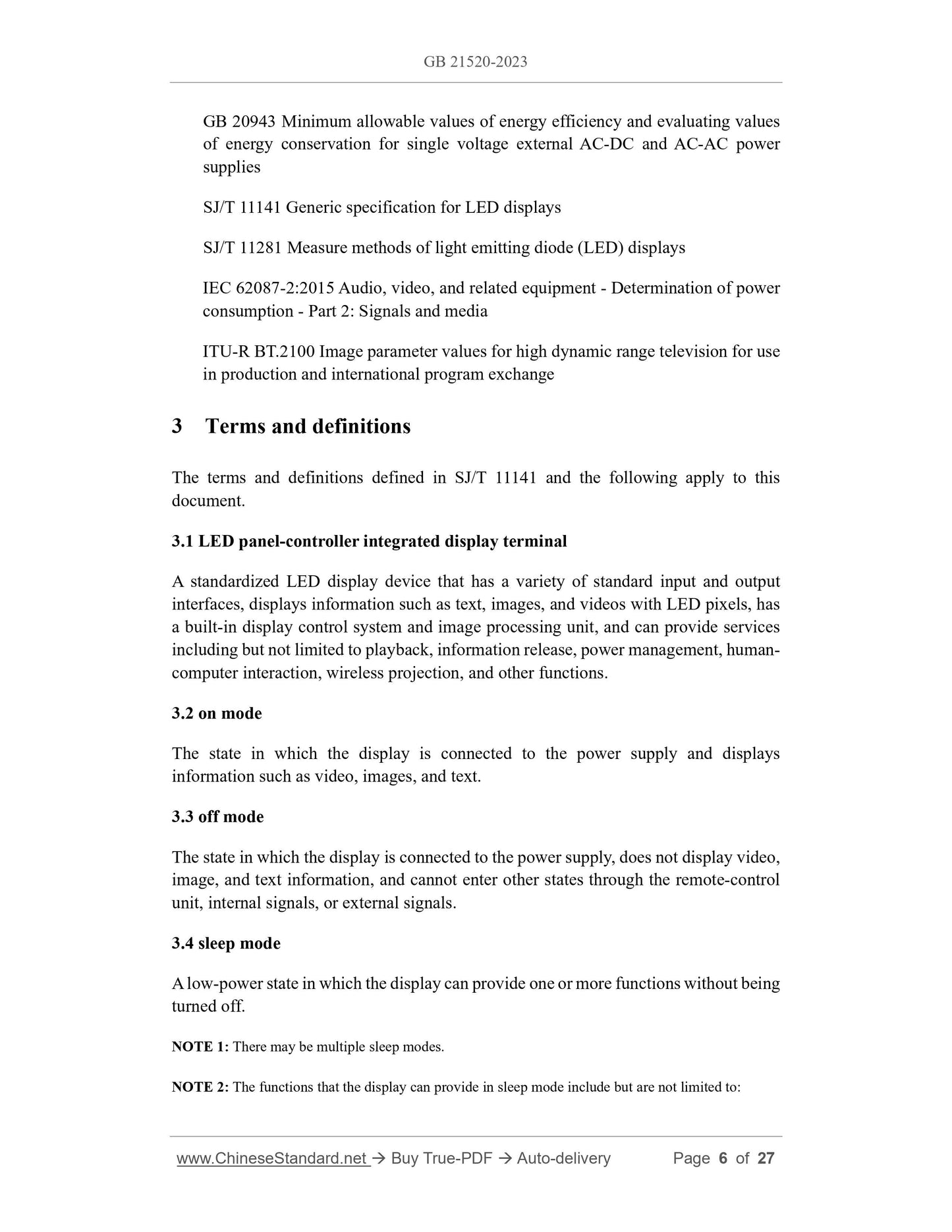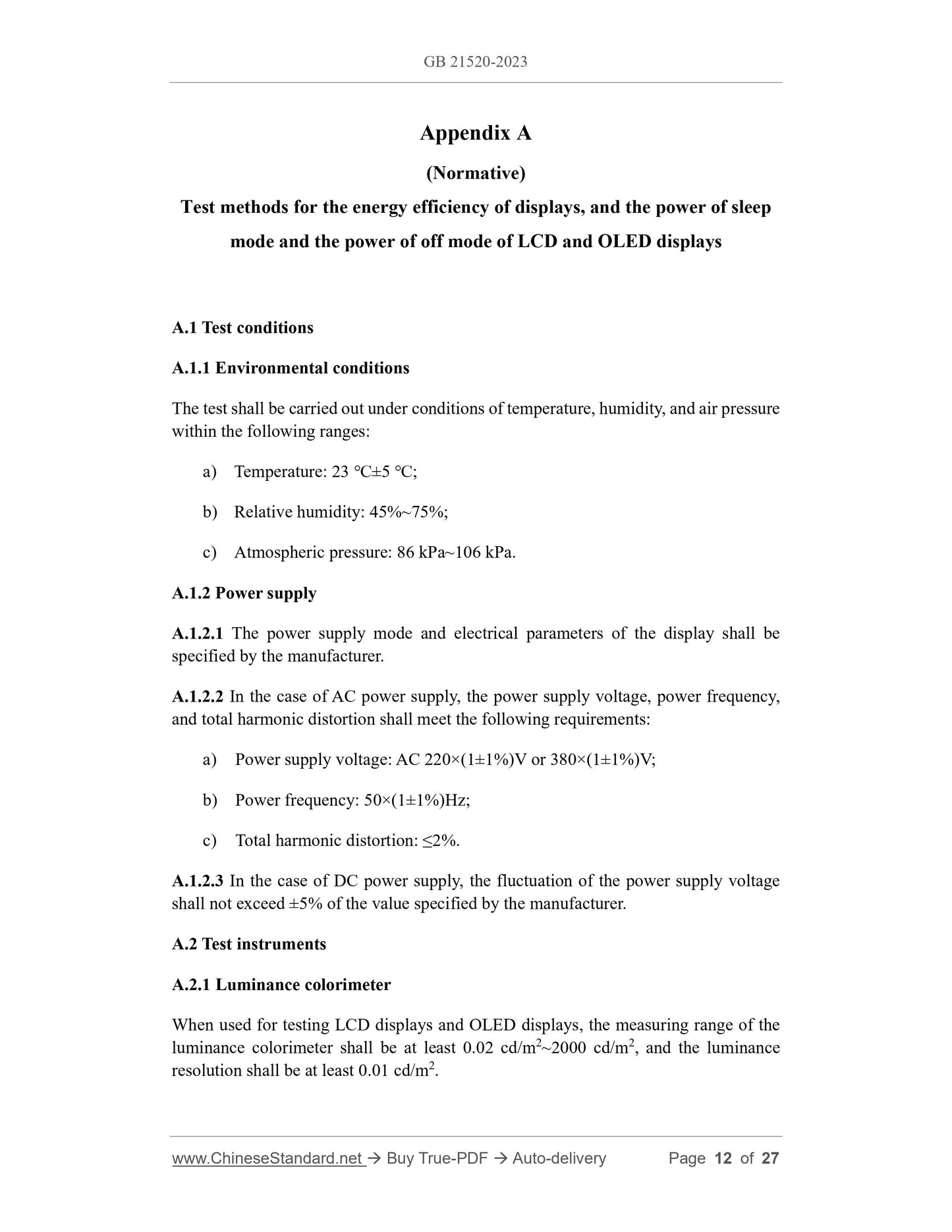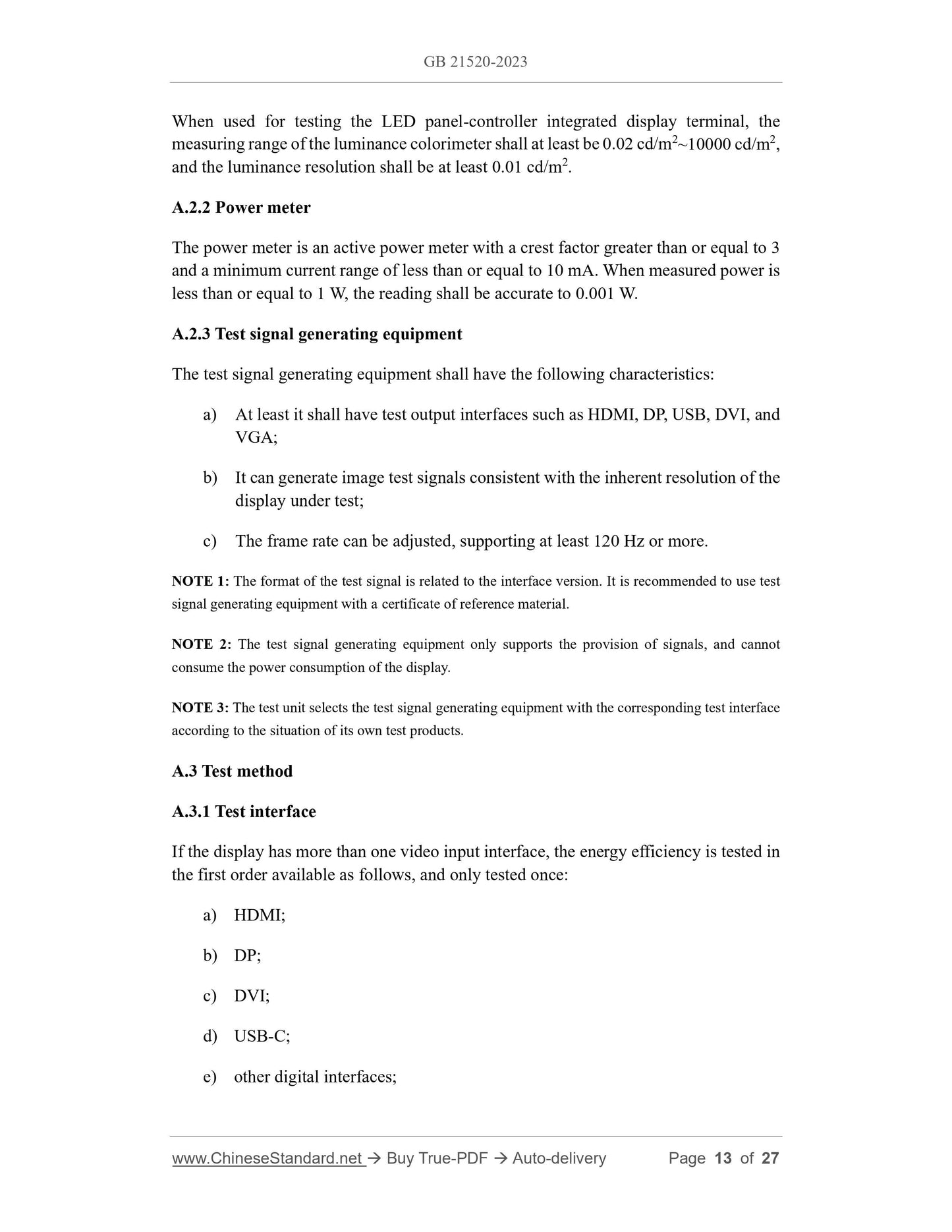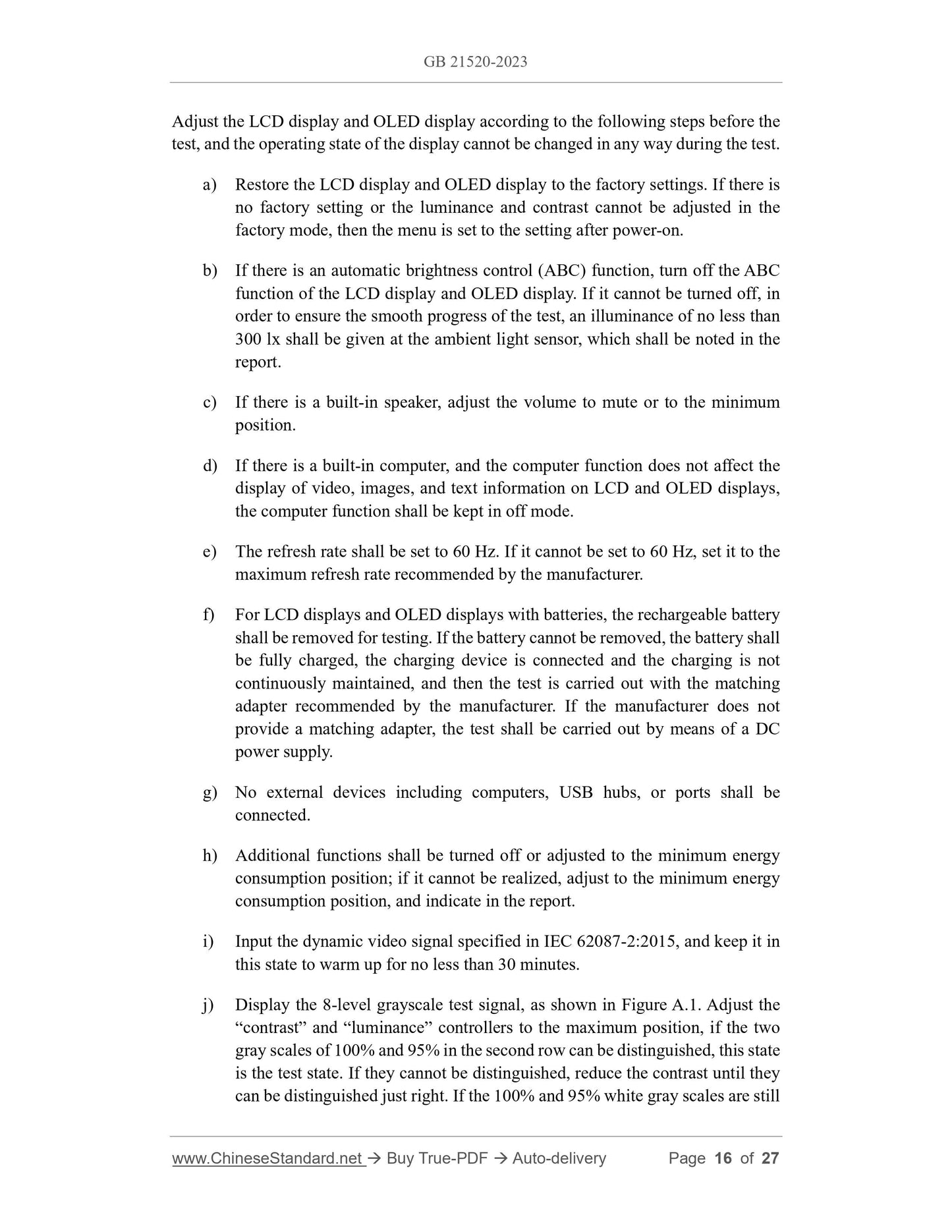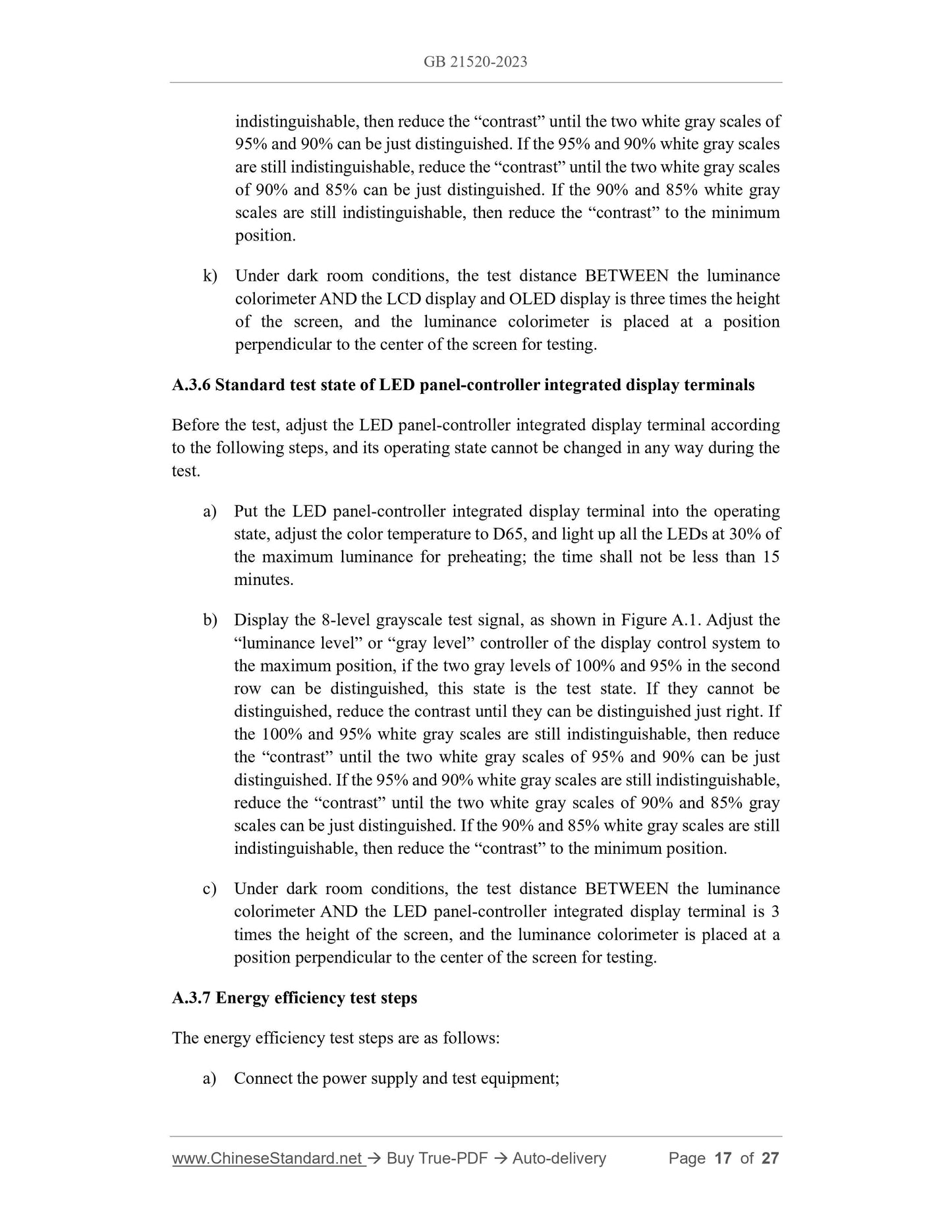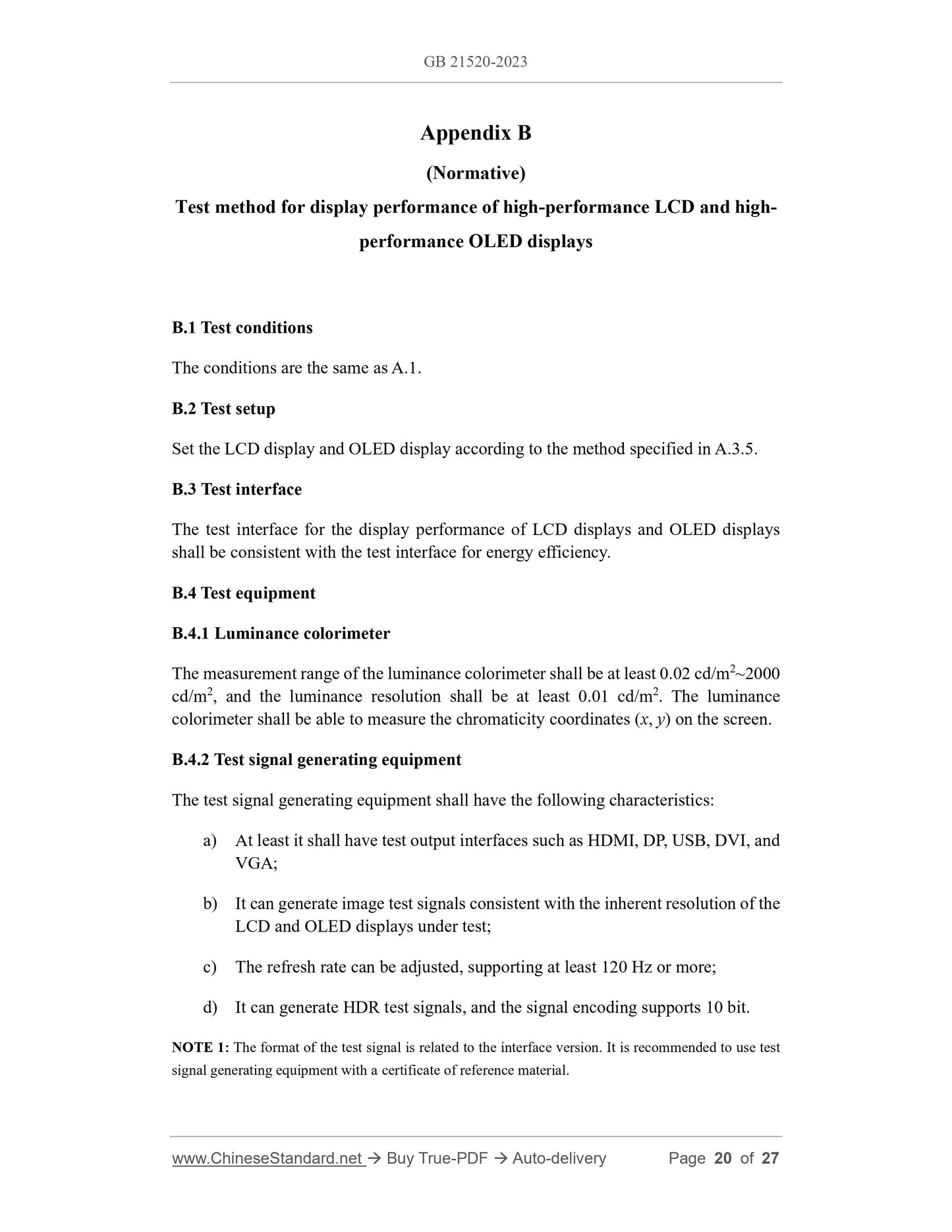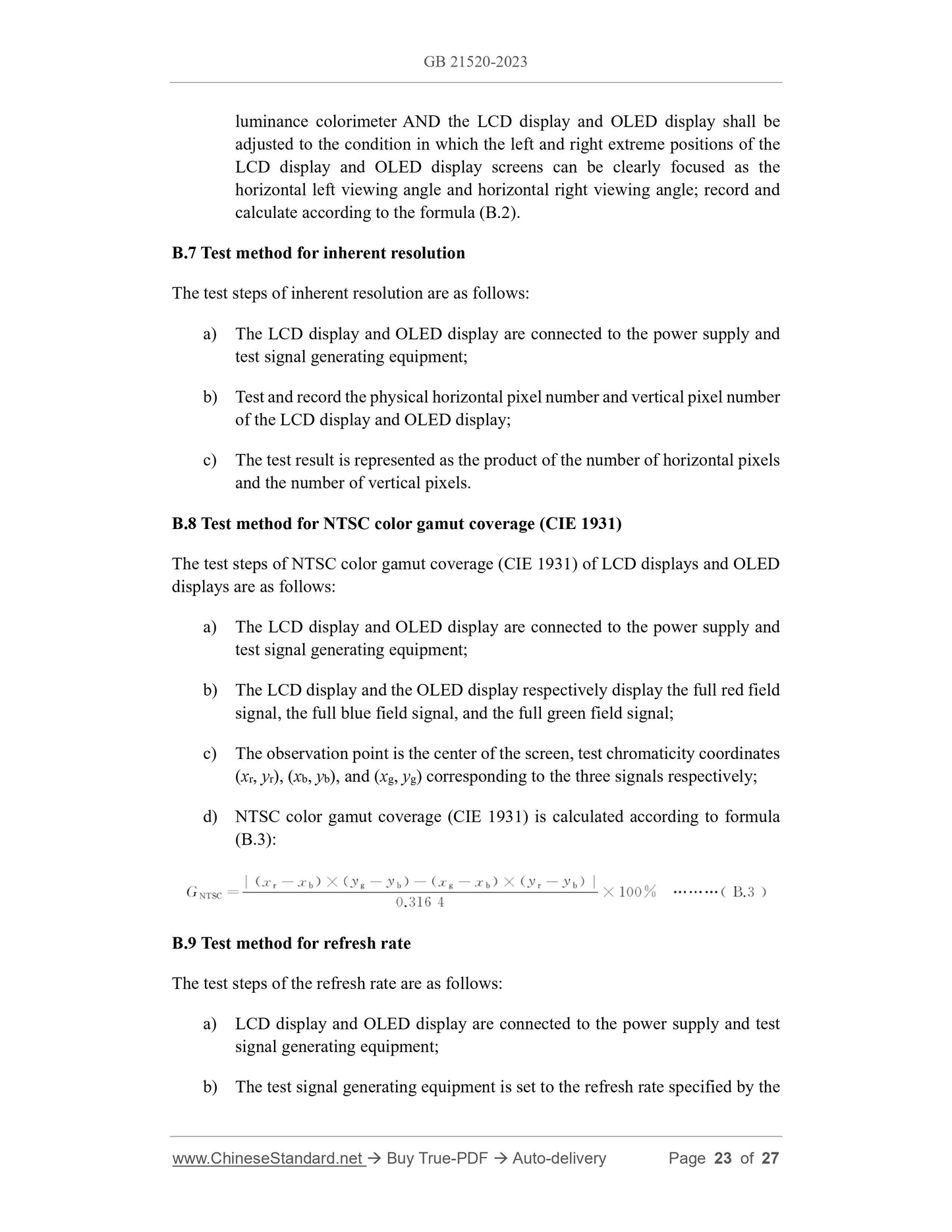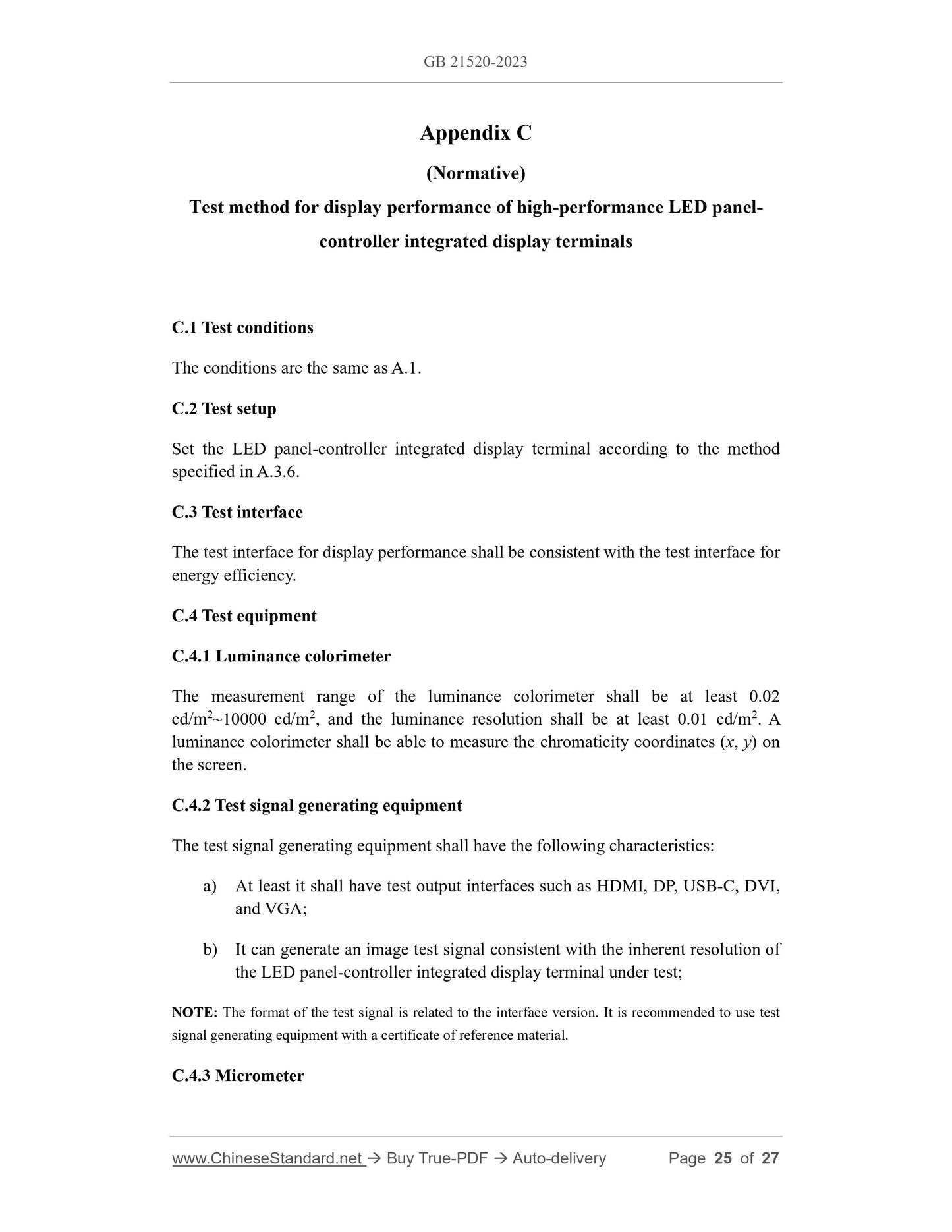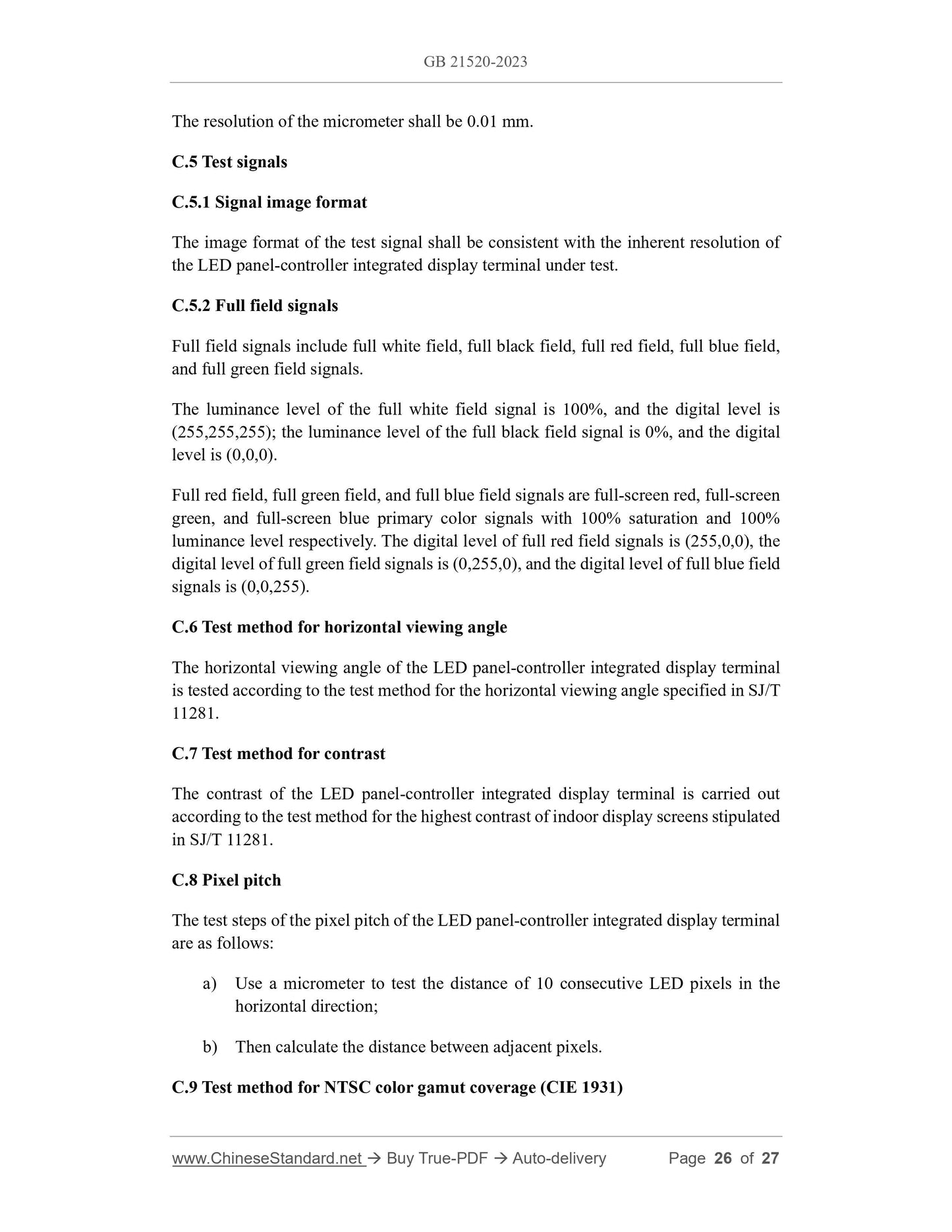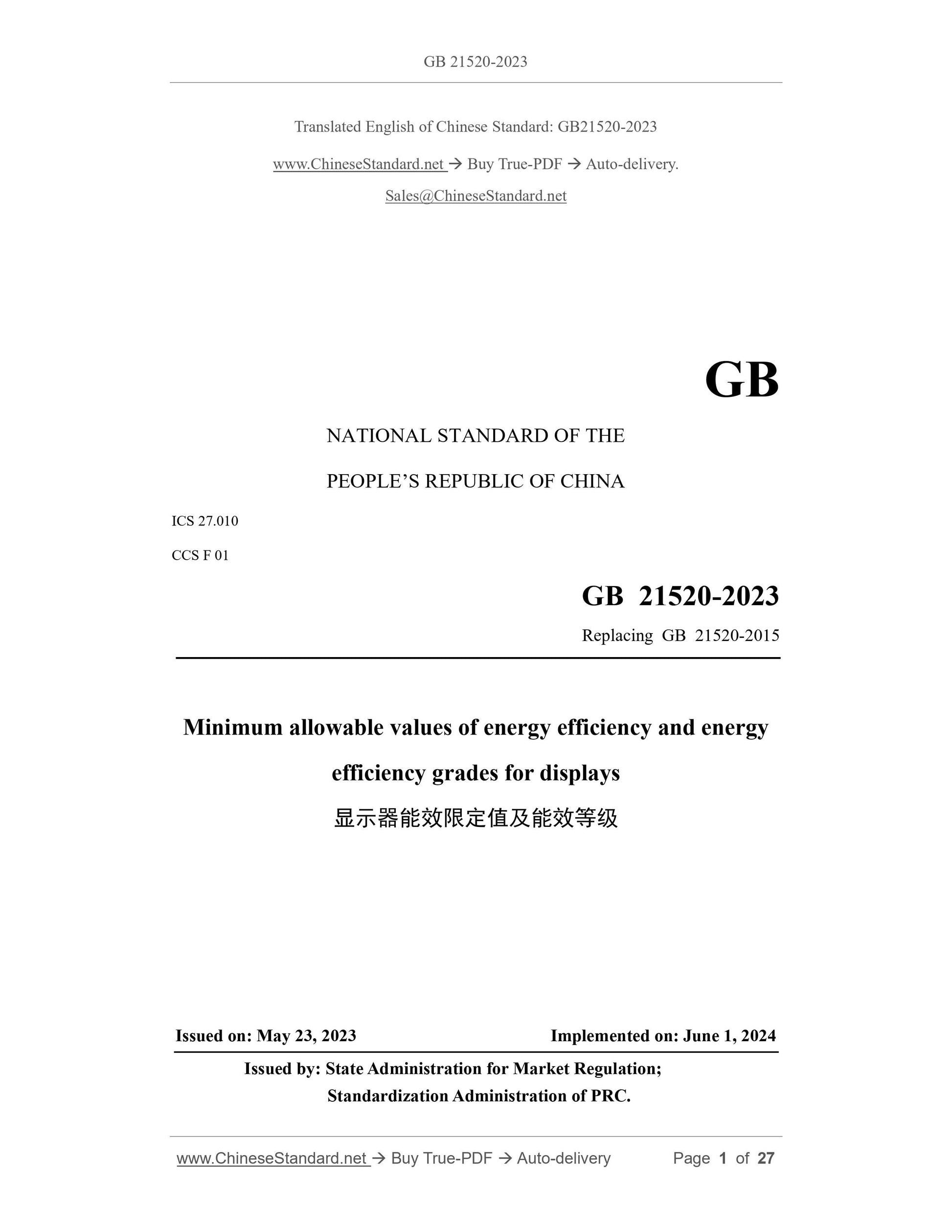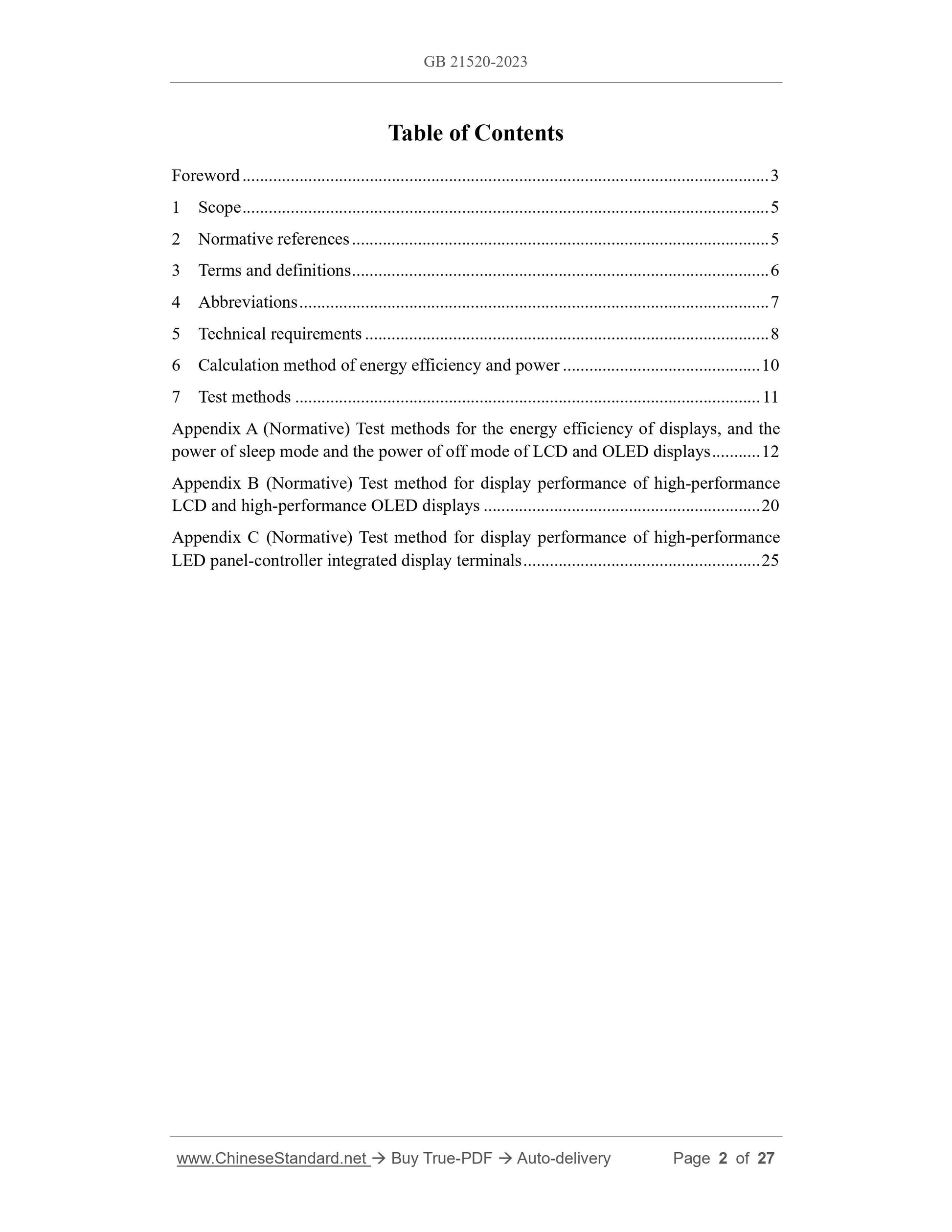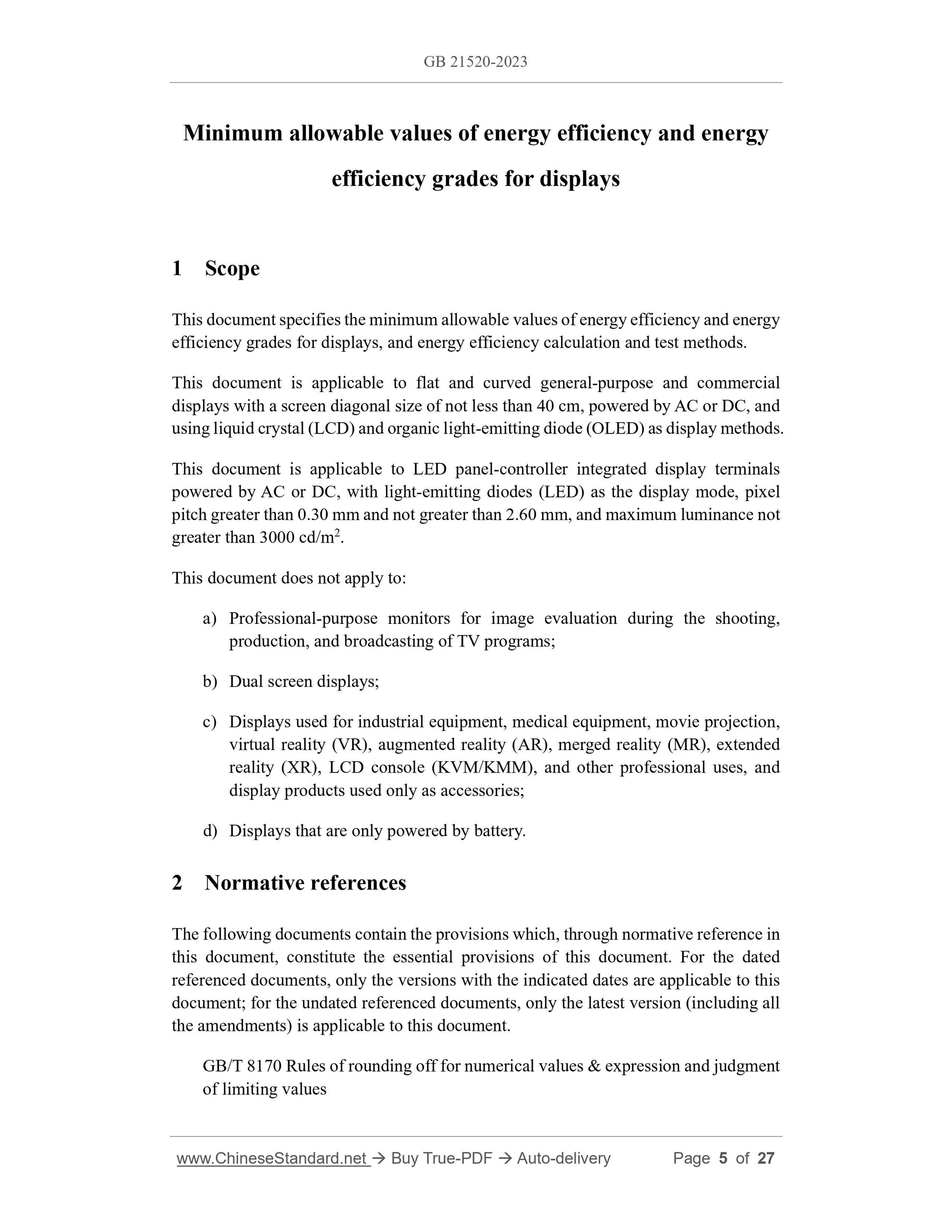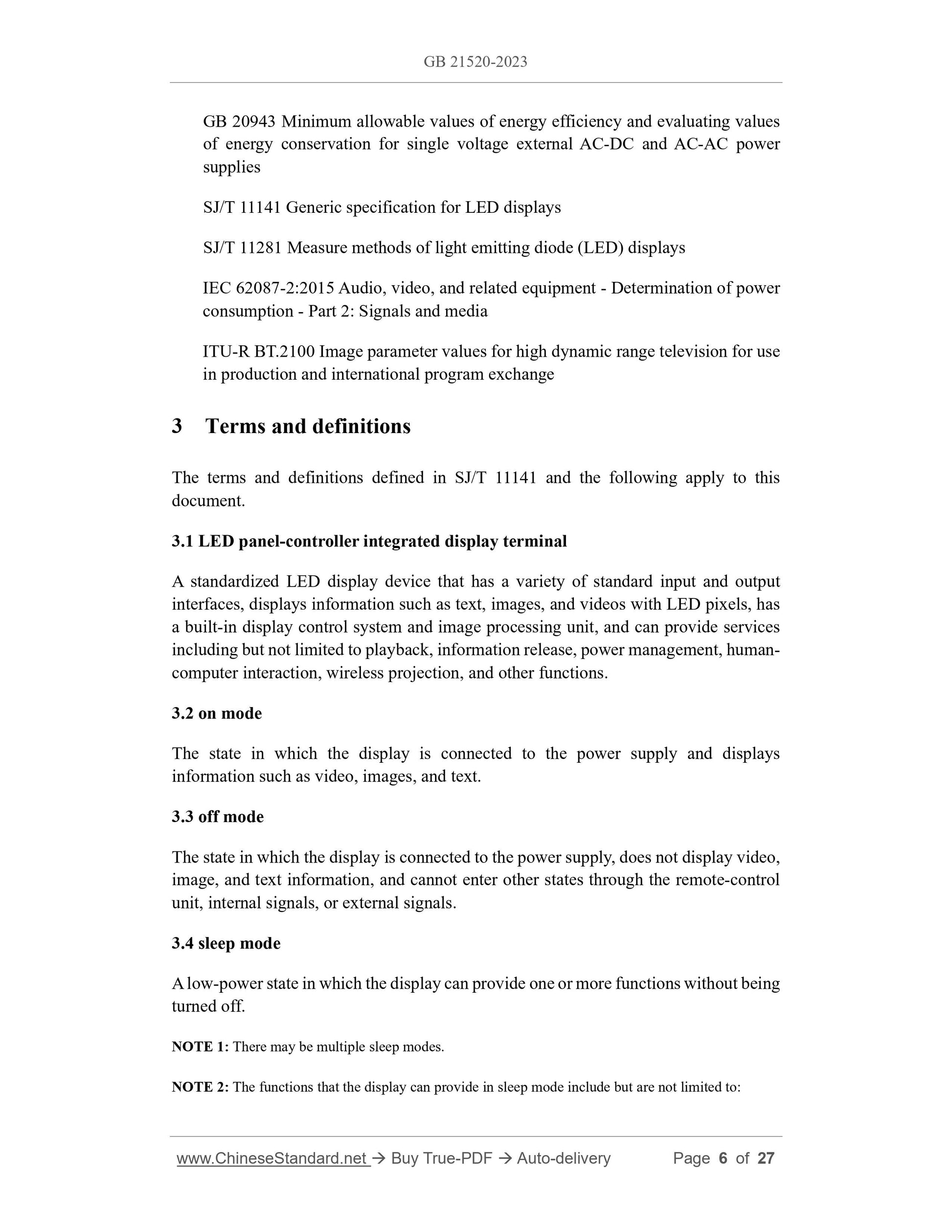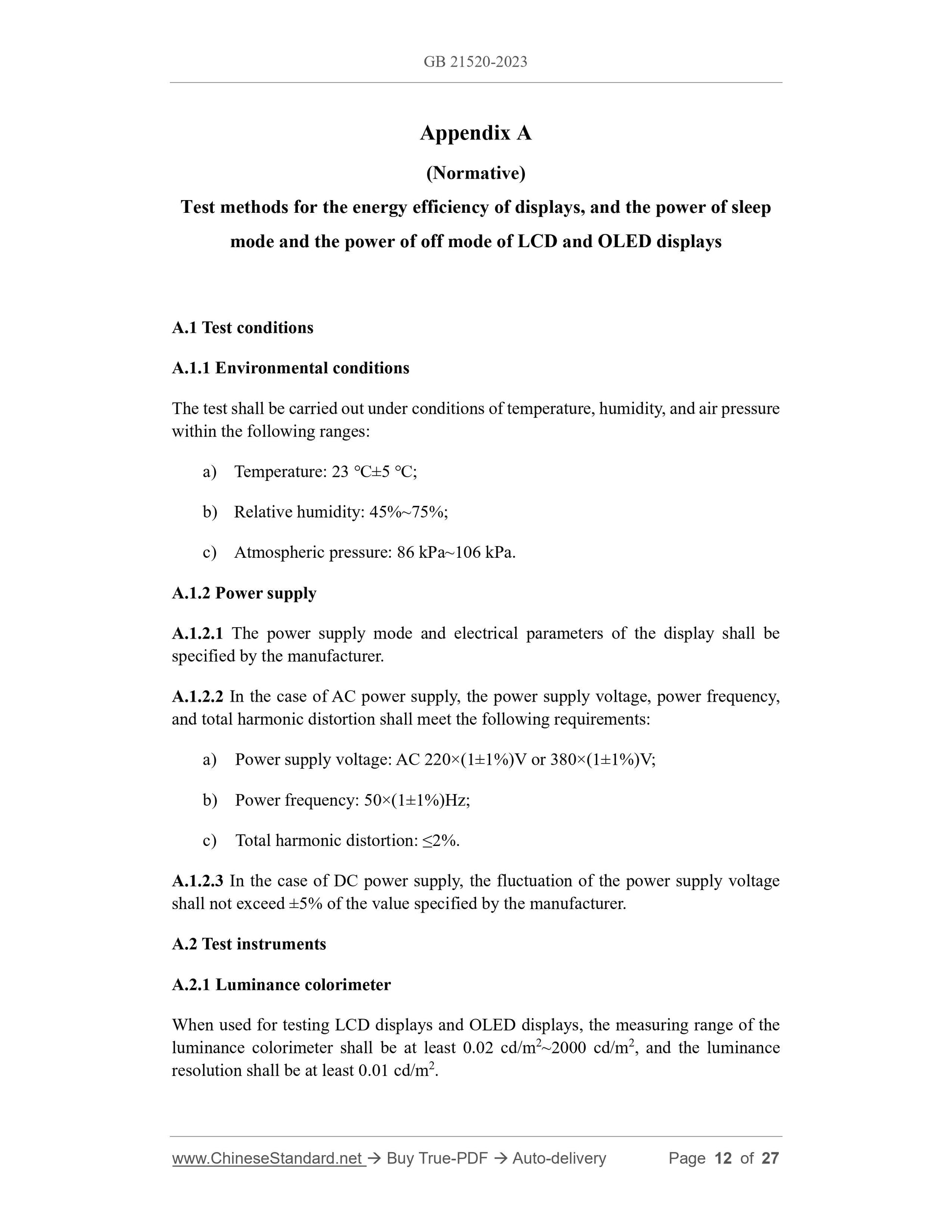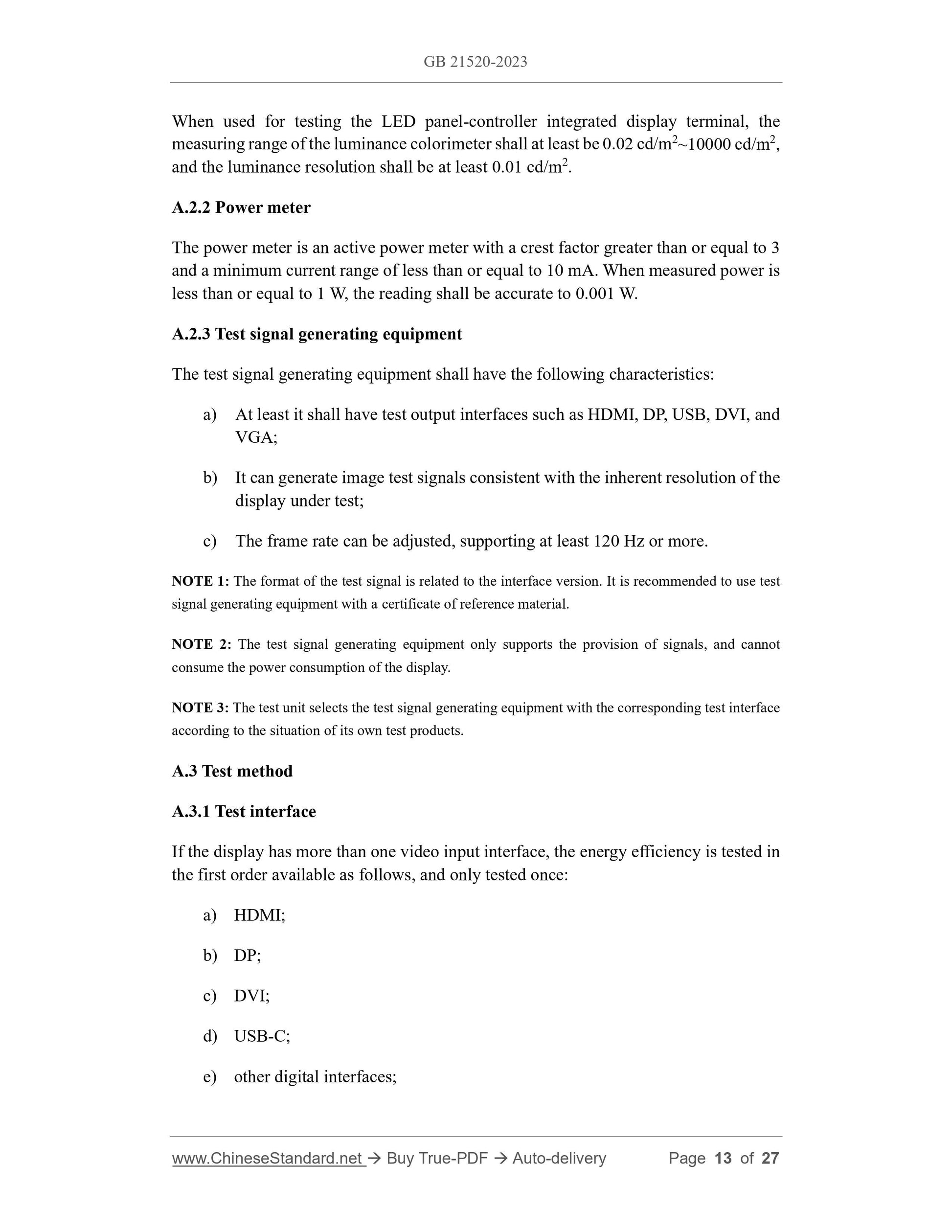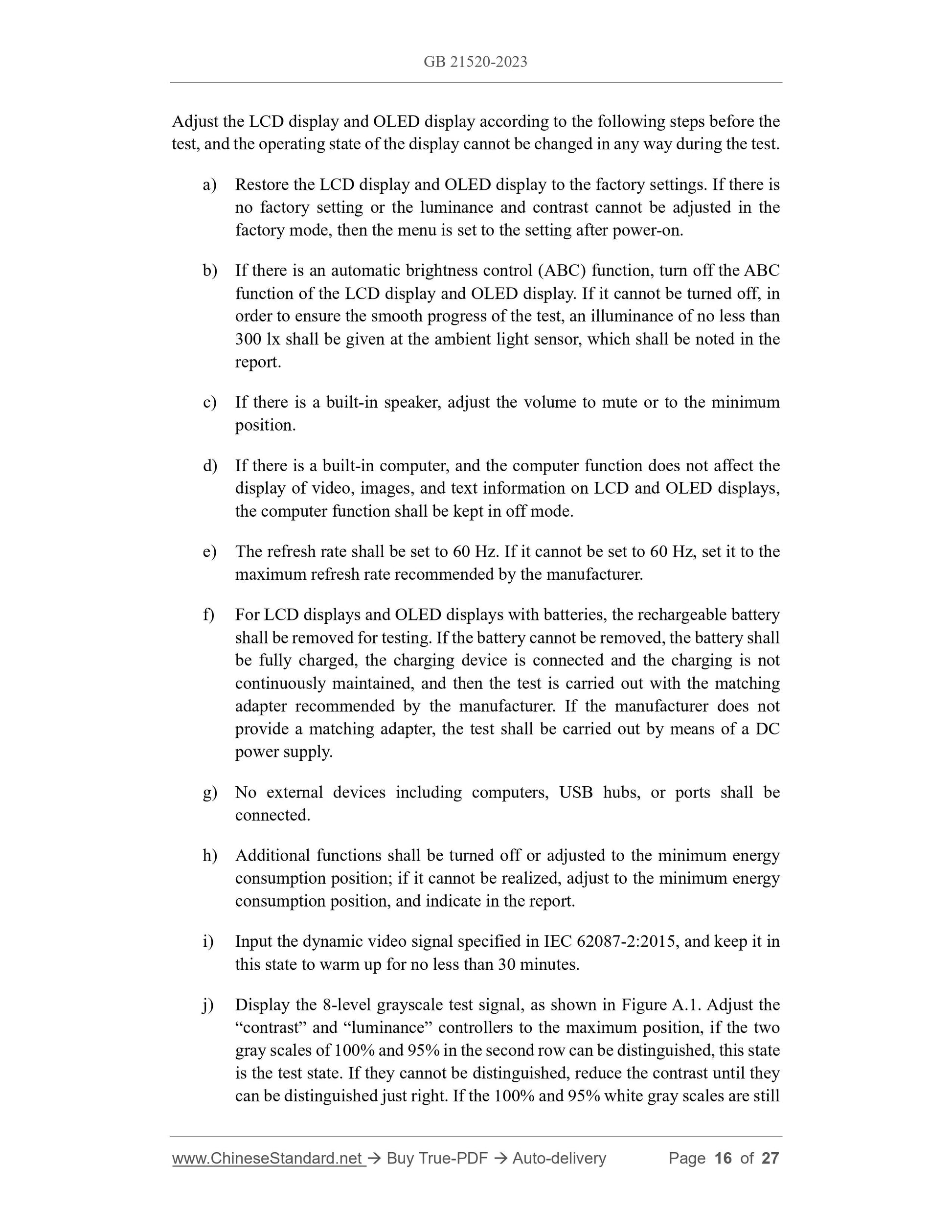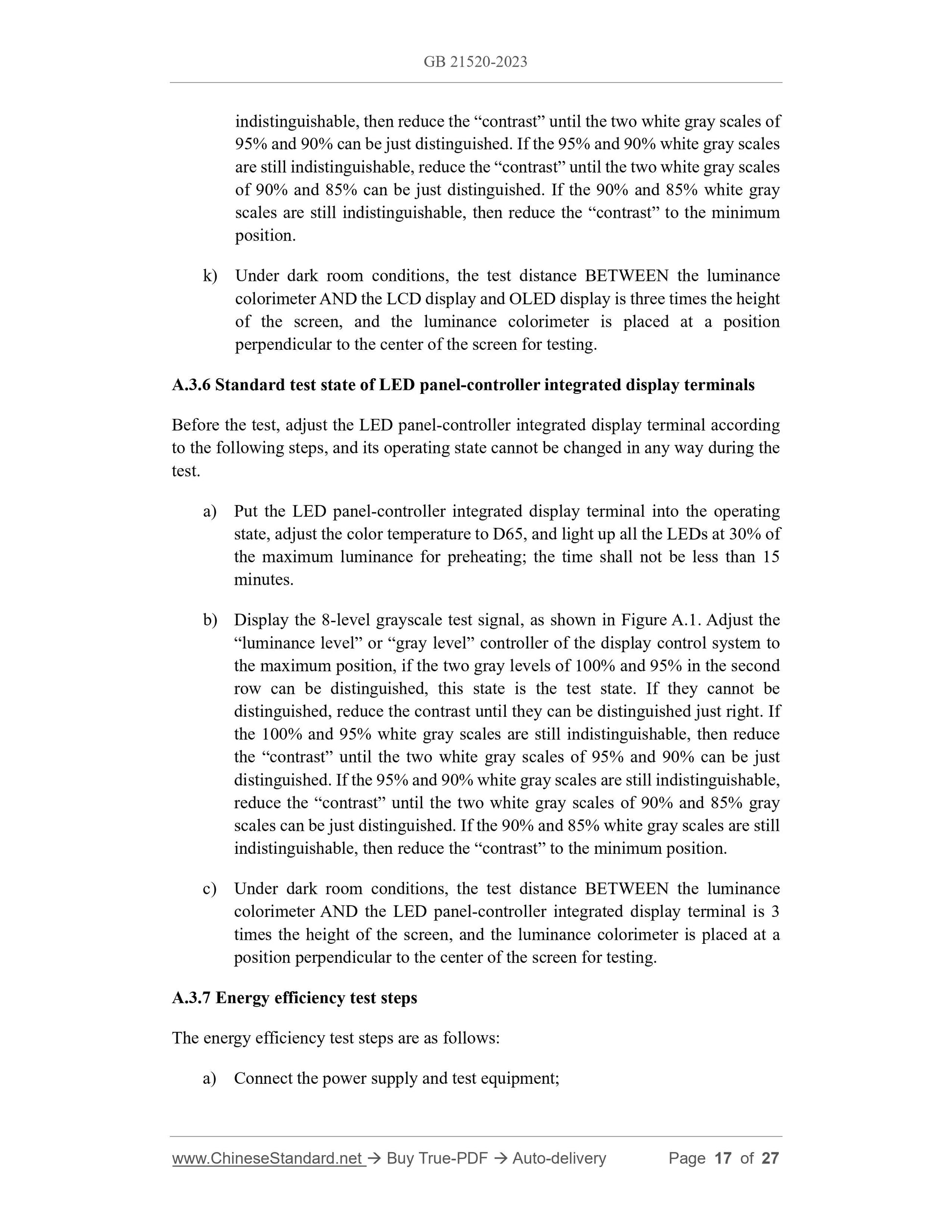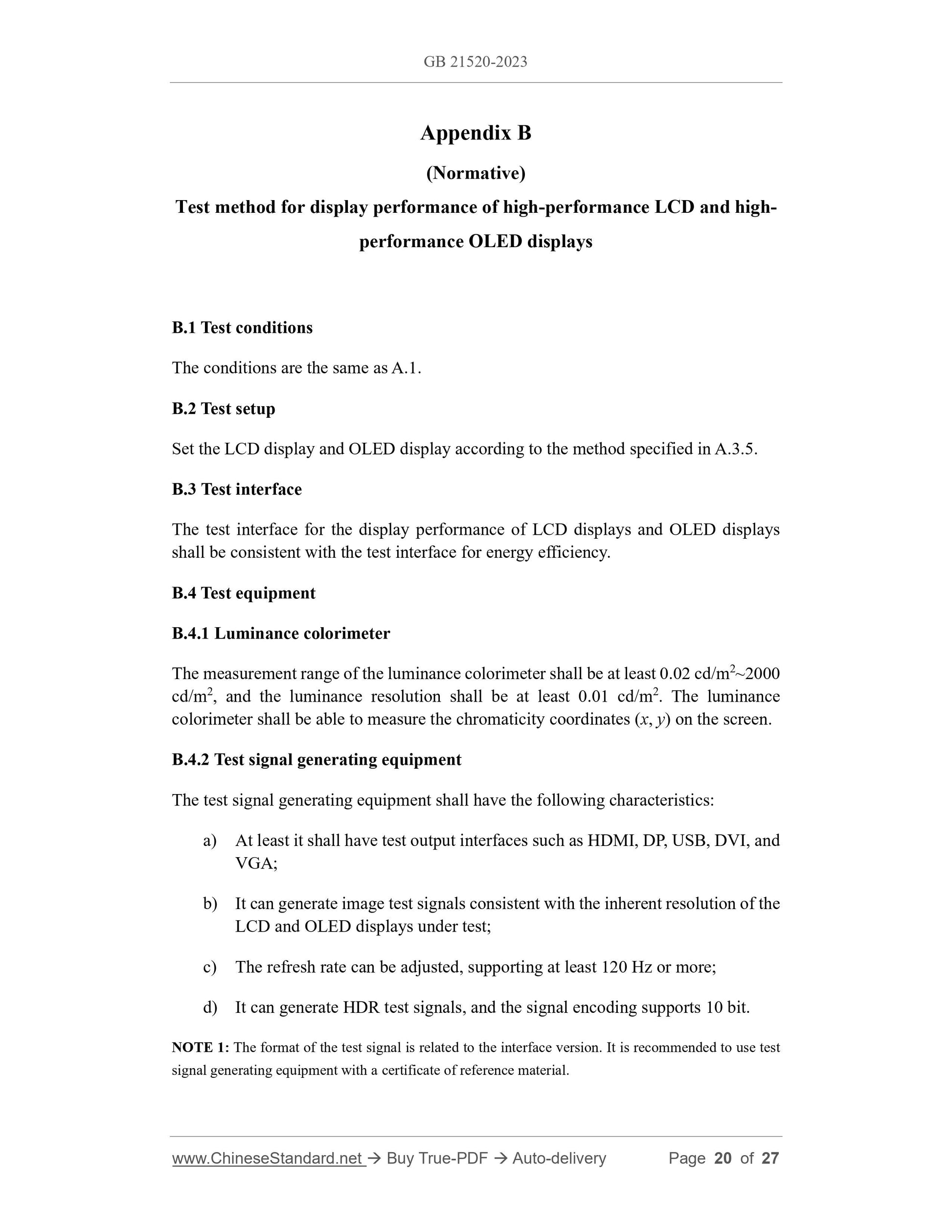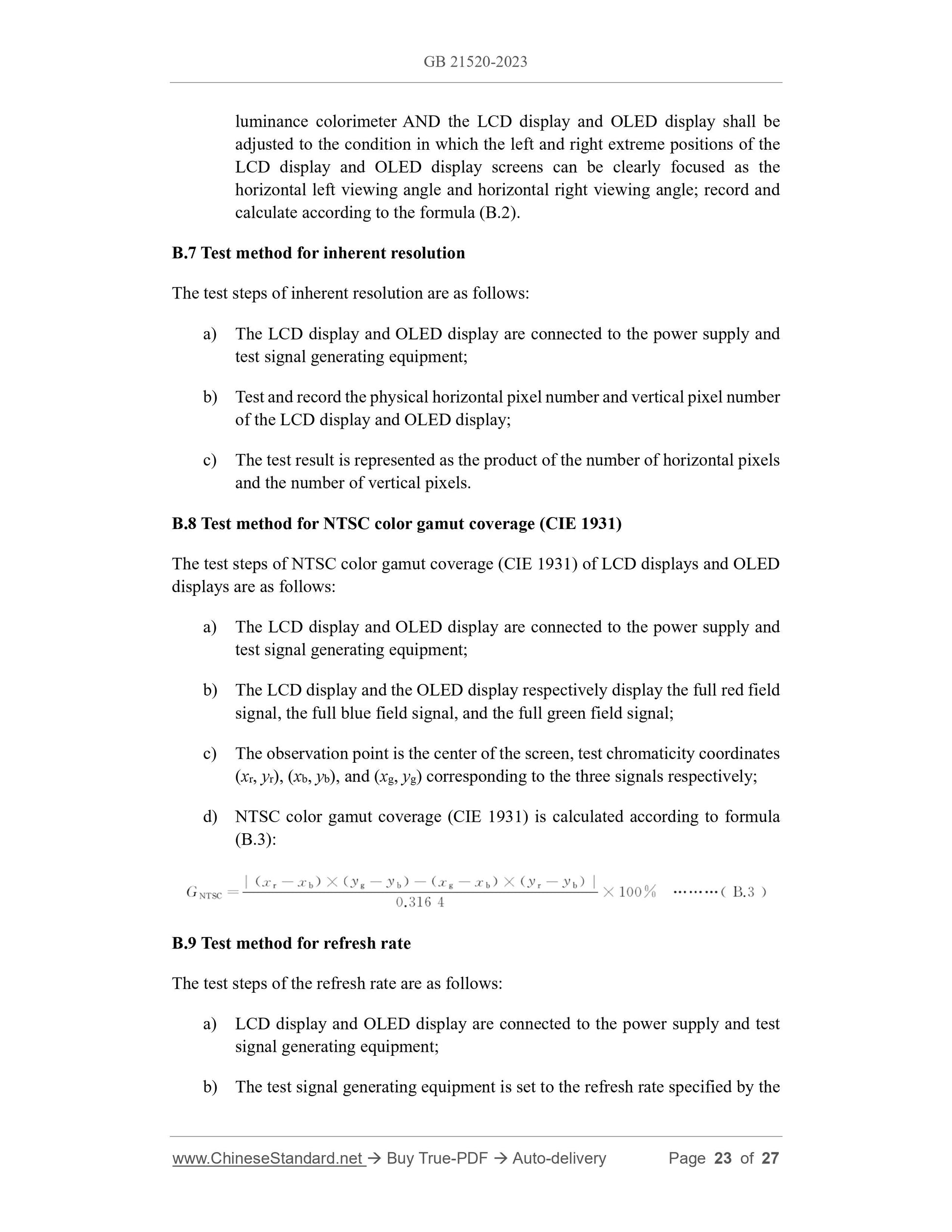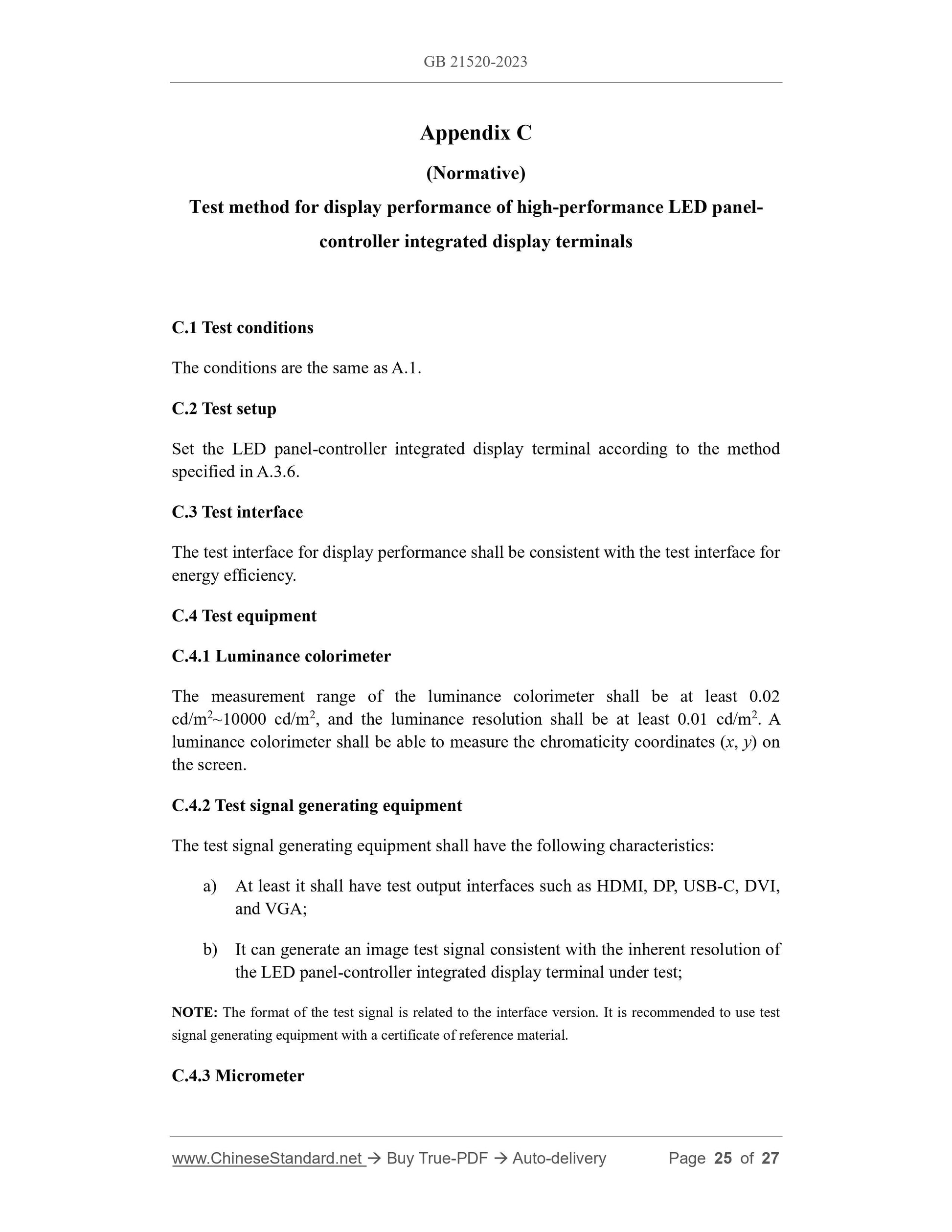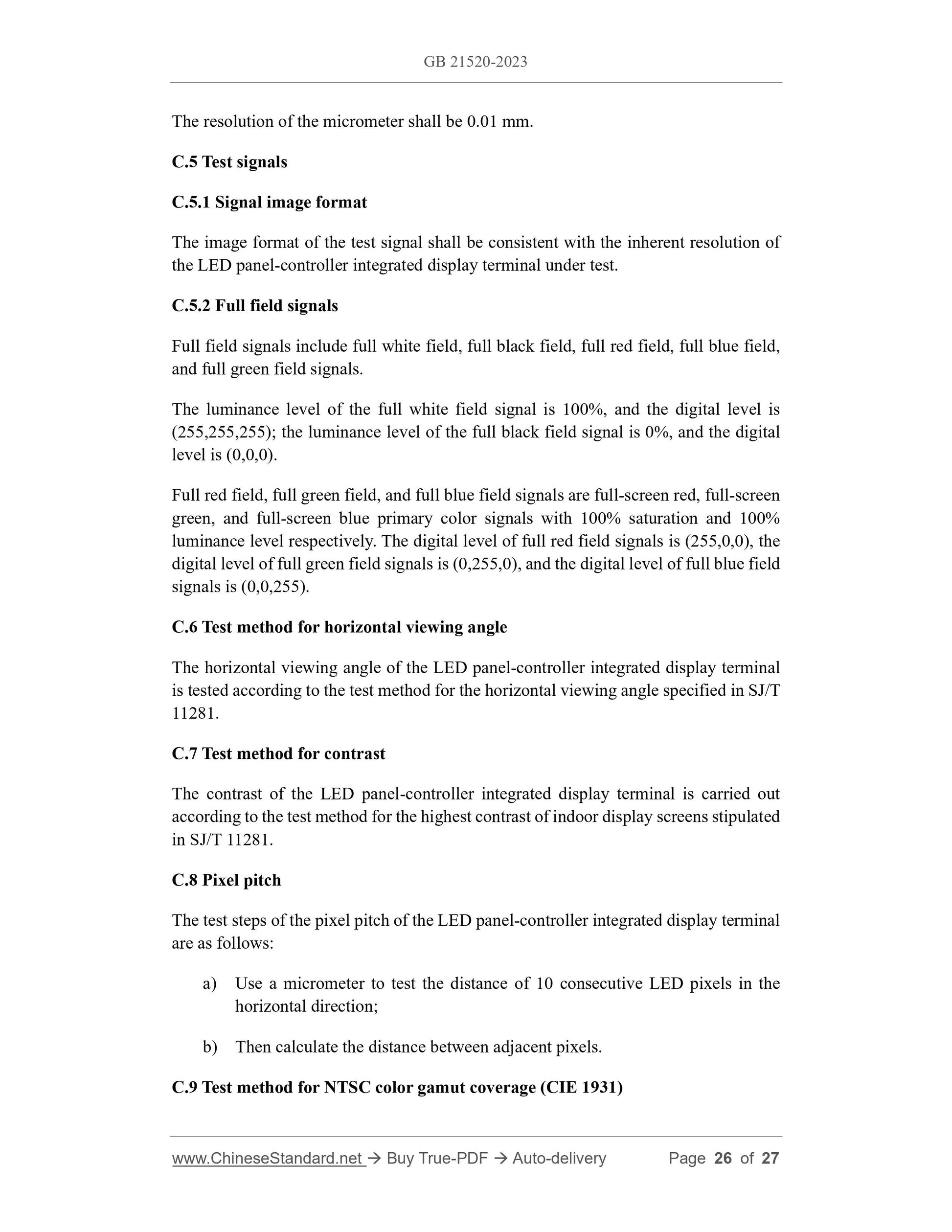1
/
of
12
www.ChineseStandard.us -- Field Test Asia Pte. Ltd.
GB 21520-2023 English PDF
GB 21520-2023 English PDF
Regular price
$305.00
Regular price
Sale price
$305.00
Unit price
/
per
Shipping calculated at checkout.
Couldn't load pickup availability
GB 21520-2023: Minimum allowable values of energy efficiency and energy efficiency grades for displays
Delivery: 9 seconds. Download (& Email) true-PDF + Invoice.
Get Quotation: Click GB 21520-2023 (Self-service in 1-minute)
Historical versions (Master-website): GB 21520-2023
Preview True-PDF (Reload/Scroll-down if blank)
GB 21520-2023
GB
NATIONAL STANDARD OF THE
PEOPLE’S REPUBLIC OF CHINA
ICS 27.010
CCS F 01
Replacing GB 21520-2015
Minimum allowable values of energy efficiency and energy
efficiency grades for displays
ISSUED ON: MAY 23, 2023
IMPLEMENTED ON: JUNE 1, 2024
Issued by: State Administration for Market Regulation;
Standardization Administration of PRC.
Table of Contents
Foreword ... 3
1 Scope ... 5
2 Normative references ... 5
3 Terms and definitions ... 6
4 Abbreviations ... 7
5 Technical requirements ... 8
6 Calculation method of energy efficiency and power ... 10
7 Test methods ... 11
Appendix A (Normative) Test methods for the energy efficiency of displays, and the
power of sleep mode and the power of off mode of LCD and OLED displays ... 12
Appendix B (Normative) Test method for display performance of high-performance
LCD and high-performance OLED displays ... 20
Appendix C (Normative) Test method for display performance of high-performance
LED panel-controller integrated display terminals ... 25
Minimum allowable values of energy efficiency and energy
efficiency grades for displays
1 Scope
This document specifies the minimum allowable values of energy efficiency and energy
efficiency grades for displays, and energy efficiency calculation and test methods.
This document is applicable to flat and curved general-purpose and commercial
displays with a screen diagonal size of not less than 40 cm, powered by AC or DC, and
using liquid crystal (LCD) and organic light-emitting diode (OLED) as display methods.
This document is applicable to LED panel-controller integrated display terminals
powered by AC or DC, with light-emitting diodes (LED) as the display mode, pixel
pitch greater than 0.30 mm and not greater than 2.60 mm, and maximum luminance not
greater than 3000 cd/m2.
This document does not apply to:
a) Professional-purpose monitors for image evaluation during the shooting,
production, and broadcasting of TV programs;
b) Dual screen displays;
c) Displays used for industrial equipment, medical equipment, movie projection,
virtual reality (VR), augmented reality (AR), merged reality (MR), extended
reality (XR), LCD console (KVM/KMM), and other professional uses, and
display products used only as accessories;
d) Displays that are only powered by battery.
2 Normative references
The following documents contain the provisions which, through normative reference in
this document, constitute the essential provisions of this document. For the dated
referenced documents, only the versions with the indicated dates are applicable to this
document; for the undated referenced documents, only the latest version (including all
the amendments) is applicable to this document.
GB/T 8170 Rules of rounding off for numerical values and expression and judgment
of limiting values
GB 20943 Minimum allowable values of energy efficiency and evaluating values
of energy conservation for single voltage external AC-DC and AC-AC power
supplies
SJ/T 11141 Generic specification for LED displays
SJ/T 11281 Measure methods of light emitting diode (LED) displays
IEC 62087-2:2015 Audio, video, and related equipment - Determination of power
consumption - Part 2: Signals and media
ITU-R BT.2100 Image parameter values for high dynamic range television for use
in production and international program exchange
3 Terms and definitions
The terms and definitions defined in SJ/T 11141 and the following apply to this
document.
3.1 LED panel-controller integrated display terminal
A standardized LED display device that has a variety of standard input and output
interfaces, displays information such as text, images, and videos with LED pixels, has
a built-in display control system and image processing unit, and can provide services
including but not limited to playback, information release, power management, human-
computer interaction, wireless projection, and other functions.
3.2 on mode
The state in which the display is connected to the power supply and displays
information such as video, images, and text.
3.3 off mode
The state in which the display is connected to the power supply, does not display video,
image, and text information, and cannot enter other states through the remote-control
unit, internal signals, or external signals.
3.4 sleep mode
A low-power state in which the display can provide one or more functions without being
turned off.
NOTE 1: There may be multiple sleep modes.
NOTE 2: The functions that the display can provide in sleep mode include but are not limited to:
Appendix A
(Normative)
Test methods for the energy efficiency of displays, and the power of sleep
mode and the power of off mode of LCD and OLED displays
A.1 Test conditions
A.1.1 Environmental conditions
The test shall be carried out under conditions of temperature, humidity, and air pressure
within the following ranges:
a) Temperature: 23 ℃±5 ℃;
b) Relative humidity: 45%~75%;
c) Atmospheric pressure: 86 kPa~106 kPa.
A.1.2 Power supply
A.1.2.1 The power supply mode and electrical parameters of the display shall be
specified by the manufacturer.
A.1.2.2 In the case of AC power supply, the power supply voltage, power frequency,
and total harmonic distortion shall meet the following requirements:
a) Power supply voltage: AC 220×(1±1%)V or 380×(1±1%)V;
b) Power frequency: 50×(1±1%)Hz;
c) Total harmonic distortion: ≤2%.
A.1.2.3 In the case of DC power supply, the fluctuation of the power supply voltage
shall not exceed ±5% of the value specified by the manufacturer.
A.2 Test instruments
A.2.1 Luminance colorimeter
When used for testing LCD displays and OLED displays, the measuring range of the
luminance colorimeter shall be at least 0.02 cd/m2~2000 cd/m2, and the luminance
resolution shall be at least 0.01 cd/m2.
When used for testing the LED panel-controller integrated display terminal, the
measuring range of the luminance colorimeter shall at least be 0.02 cd/m2~10000 cd/m2,
and the luminance resolution shall be at least 0.01 cd/m2.
A.2.2 Power meter
The power meter is an active power meter with a crest factor greater than or equal to 3
and a minimum current range of less than or equal to 10 mA. When measured power is
less than or equal to 1 W, the reading shall be accurate to 0.001 W.
A.2.3 Test signal generating equipment
The test signal generating equipment shall have the following characteristics:
a) At least it shall have test output interfaces such as HDMI, DP, USB, DVI, and
VGA;
b) It can generate image test signals consistent with the inherent resolution of the
display under test;
c) The frame rate can be adjusted, supporting at least 120 Hz or more.
NOTE 1: The format of the test signal is related to the interface version. It is recommended to use test
signal generating equipment with a certificate of reference material.
NOTE 2: The test signal generating equipment only supports the provision of signals, and cannot
consume the power consumption of the display.
NOTE 3: The test unit selects the test signal generating equipment with the corresponding test interface
according to the situation of its own test products.
A.3 Test method
A.3.1 Test interface
If the display has more than one video input interface, the energy efficiency is tested in
the first order available as follows, and only tested once:
a) HDMI;
b) DP;
c) DVI;
d) USB-C;
e) other digital interfaces;
Adjust the LCD display and OLED display according to the following steps before the
test, and the operating state of the display cannot be changed in any way during the test.
a) Restore the LCD display and OLED display to the factory settings. If there is
no factory setting or the luminance and contrast cannot be adjusted in the
factory mode, then the menu is set to the setting after power-on.
b) If there is an automatic brightness control (ABC) function, turn off the ABC
function of the LCD display and OLED display. If it cannot be turned off, in
order to ensure the smooth progress of the test, an illuminance of no less than
300 lx shall be given at the ambient light sensor, which shall be noted in the
report.
c) If there is a built-in speaker, adjust the volume to mute or to the minimum
position.
d) If there is a built-in computer, and the computer function does not affect the
display of video, images, and text information on LCD and OLED displays,
the computer function shall be kept in off mode.
e) The refresh rate shall be set to 60 Hz. If it cannot be set to 60 Hz, set it to the
maximum refresh rate recommended by the manufacturer.
f) For LCD displays and OLED displays with batteries, the rechargeable battery
shall be removed for testing. If the battery cannot be removed, the battery shall
be fully charged, the charging device is connected and the charging is not
continuously maintained, and then the test is carried out with the matching
adapter recommended by the manufacturer. If the manufacturer does not
provide a matching adapter, the test shall be carried out by means of a DC
power supply.
g) No external devices including computers, USB hubs, or ports shall be
connected.
h) Additional functions shall be turned off or adjusted to the minimum energy
consumption position; if it cannot be realized, adjust to the minimum energy
consumption position, and indicate in the report.
i) Input the dynamic video signal specified in IEC 62087-2:2015, and keep it in
this state to warm up for no less than 30 minutes.
j) Display the 8-level grayscale test signal, as shown in Figure A.1. Adjust the
“contrast” and “luminance” controllers to the maximum position, if the two
gray scales of 100% and 95% in the second row can be distinguished, this state
is the test state. If they cannot be distinguished, reduce the contrast until they
can be distinguished just right. If the 100% and 95% white gray scales are still
indistinguishable, then reduce the “contrast” until the two white gray scales of
95% and 90% can be just distinguished. If the 95% and 90% white gray scales
are still indistinguishable, reduce the “contrast” until the two white gray scales
of 90% and 85% can be just distinguished. If the 90% and 85% white gray
scales are still indistinguishable, then reduce the “contrast” to the minimum
position.
k) Under dark room conditions, the test distance BETWEEN the luminance
colorimeter AND the LCD display and OLED display is three times the height
of the screen, and the luminance colorimeter is placed at a position
perpendicular to the center of the screen for testing.
A.3.6 Standard test state of LED panel-controller integrated display terminals
Before the test, adjust the LED panel-controller integrated display terminal according
to the following steps, and its operating state cannot be changed in any way during the
test.
a) Put the LED panel-controller integrated display terminal into the operating
state, adjust the color temperature to D65, and light up all the LEDs at 30% of
the maximum luminance for preheating; the time shall not be less than 15
minutes.
b) Display the 8-level grayscale test signal, as shown in Figure A.1. Adjust the
“luminance level” or “gray level” controller of the display control system to
the maximum position, if the two gray levels of 100% and 95% in the second
row can be distinguished, this state is the test state. If they cannot be
distinguished, reduce the contrast until they can be distinguished just right. If
the 100% and 95% white gray scales are still indistinguishable, then reduce
the “contrast” until the two white gray scales of 95% and 90% can be just
distinguished. If the 95% and 90% white gray scales are still indistinguishable,
reduce the “contrast” until the two white gray scales of 90% and 85% gray
scales can be just distinguished. If the 90% and 85% white gray scales are still
indistinguishable, then reduce the “contrast” to the minimum position.
c) Under dark room conditions, the test distance BETWEEN the luminance
colorimeter AND the LED panel-controller integrated display terminal is 3
times the height of the screen, and the luminance colorimeter is placed at a
position perpendicular to the center of the screen for testing.
A.3.7 Energy efficiency test steps
The energy efficiency test steps are as follows:
a) Connect the power supply and test equipment;
Appendix B
(Normative)
Test method for display performance of high-performance LCD and high-
performance OLED displays
B.1 Test conditions
The conditions are the same as A.1.
B.2 Test setup
Set the LCD display and OLED display according to the method specified in A.3.5.
B.3 Test interface
The test interface for the display performance of LCD displays and OLED displays
shall be consistent with the test interface for energy efficiency.
B.4 Test equipment
B.4.1 Luminance colorimeter
The measurement range of the luminance colorimeter shall be at least 0.02 cd/m2~2000
cd/m2, and the luminance resolution shall be at least 0.01 cd/m2. The luminance
colorimeter shall be able to measure the chromaticity coordinates (x, y) on the screen.
B.4.2 Test signal generating equipment
The test signal generating equipment shall have the following characteristics:
a) At least it shall have test output interfaces such as HDMI, DP, USB, DVI, and
VGA;
b) It can generate image test signals consistent with the inherent resolution of the
LCD and OLED displays under test;
c) The refresh rate can be adjusted, supporting at least 120 Hz or more;
d) It can generate HDR test signals, and the signal encoding supports 10 bit.
NOTE 1: The format of the test signal is related to the interface version. It is recommended to use test
signal generating equipment with a certificate of reference material.
luminance colorimeter AND the LCD display and OLED display shall be
adjusted to the condition in which the left and right extreme positions of the
LCD display and OLED display screens can be...
Delivery: 9 seconds. Download (& Email) true-PDF + Invoice.
Get Quotation: Click GB 21520-2023 (Self-service in 1-minute)
Historical versions (Master-website): GB 21520-2023
Preview True-PDF (Reload/Scroll-down if blank)
GB 21520-2023
GB
NATIONAL STANDARD OF THE
PEOPLE’S REPUBLIC OF CHINA
ICS 27.010
CCS F 01
Replacing GB 21520-2015
Minimum allowable values of energy efficiency and energy
efficiency grades for displays
ISSUED ON: MAY 23, 2023
IMPLEMENTED ON: JUNE 1, 2024
Issued by: State Administration for Market Regulation;
Standardization Administration of PRC.
Table of Contents
Foreword ... 3
1 Scope ... 5
2 Normative references ... 5
3 Terms and definitions ... 6
4 Abbreviations ... 7
5 Technical requirements ... 8
6 Calculation method of energy efficiency and power ... 10
7 Test methods ... 11
Appendix A (Normative) Test methods for the energy efficiency of displays, and the
power of sleep mode and the power of off mode of LCD and OLED displays ... 12
Appendix B (Normative) Test method for display performance of high-performance
LCD and high-performance OLED displays ... 20
Appendix C (Normative) Test method for display performance of high-performance
LED panel-controller integrated display terminals ... 25
Minimum allowable values of energy efficiency and energy
efficiency grades for displays
1 Scope
This document specifies the minimum allowable values of energy efficiency and energy
efficiency grades for displays, and energy efficiency calculation and test methods.
This document is applicable to flat and curved general-purpose and commercial
displays with a screen diagonal size of not less than 40 cm, powered by AC or DC, and
using liquid crystal (LCD) and organic light-emitting diode (OLED) as display methods.
This document is applicable to LED panel-controller integrated display terminals
powered by AC or DC, with light-emitting diodes (LED) as the display mode, pixel
pitch greater than 0.30 mm and not greater than 2.60 mm, and maximum luminance not
greater than 3000 cd/m2.
This document does not apply to:
a) Professional-purpose monitors for image evaluation during the shooting,
production, and broadcasting of TV programs;
b) Dual screen displays;
c) Displays used for industrial equipment, medical equipment, movie projection,
virtual reality (VR), augmented reality (AR), merged reality (MR), extended
reality (XR), LCD console (KVM/KMM), and other professional uses, and
display products used only as accessories;
d) Displays that are only powered by battery.
2 Normative references
The following documents contain the provisions which, through normative reference in
this document, constitute the essential provisions of this document. For the dated
referenced documents, only the versions with the indicated dates are applicable to this
document; for the undated referenced documents, only the latest version (including all
the amendments) is applicable to this document.
GB/T 8170 Rules of rounding off for numerical values and expression and judgment
of limiting values
GB 20943 Minimum allowable values of energy efficiency and evaluating values
of energy conservation for single voltage external AC-DC and AC-AC power
supplies
SJ/T 11141 Generic specification for LED displays
SJ/T 11281 Measure methods of light emitting diode (LED) displays
IEC 62087-2:2015 Audio, video, and related equipment - Determination of power
consumption - Part 2: Signals and media
ITU-R BT.2100 Image parameter values for high dynamic range television for use
in production and international program exchange
3 Terms and definitions
The terms and definitions defined in SJ/T 11141 and the following apply to this
document.
3.1 LED panel-controller integrated display terminal
A standardized LED display device that has a variety of standard input and output
interfaces, displays information such as text, images, and videos with LED pixels, has
a built-in display control system and image processing unit, and can provide services
including but not limited to playback, information release, power management, human-
computer interaction, wireless projection, and other functions.
3.2 on mode
The state in which the display is connected to the power supply and displays
information such as video, images, and text.
3.3 off mode
The state in which the display is connected to the power supply, does not display video,
image, and text information, and cannot enter other states through the remote-control
unit, internal signals, or external signals.
3.4 sleep mode
A low-power state in which the display can provide one or more functions without being
turned off.
NOTE 1: There may be multiple sleep modes.
NOTE 2: The functions that the display can provide in sleep mode include but are not limited to:
Appendix A
(Normative)
Test methods for the energy efficiency of displays, and the power of sleep
mode and the power of off mode of LCD and OLED displays
A.1 Test conditions
A.1.1 Environmental conditions
The test shall be carried out under conditions of temperature, humidity, and air pressure
within the following ranges:
a) Temperature: 23 ℃±5 ℃;
b) Relative humidity: 45%~75%;
c) Atmospheric pressure: 86 kPa~106 kPa.
A.1.2 Power supply
A.1.2.1 The power supply mode and electrical parameters of the display shall be
specified by the manufacturer.
A.1.2.2 In the case of AC power supply, the power supply voltage, power frequency,
and total harmonic distortion shall meet the following requirements:
a) Power supply voltage: AC 220×(1±1%)V or 380×(1±1%)V;
b) Power frequency: 50×(1±1%)Hz;
c) Total harmonic distortion: ≤2%.
A.1.2.3 In the case of DC power supply, the fluctuation of the power supply voltage
shall not exceed ±5% of the value specified by the manufacturer.
A.2 Test instruments
A.2.1 Luminance colorimeter
When used for testing LCD displays and OLED displays, the measuring range of the
luminance colorimeter shall be at least 0.02 cd/m2~2000 cd/m2, and the luminance
resolution shall be at least 0.01 cd/m2.
When used for testing the LED panel-controller integrated display terminal, the
measuring range of the luminance colorimeter shall at least be 0.02 cd/m2~10000 cd/m2,
and the luminance resolution shall be at least 0.01 cd/m2.
A.2.2 Power meter
The power meter is an active power meter with a crest factor greater than or equal to 3
and a minimum current range of less than or equal to 10 mA. When measured power is
less than or equal to 1 W, the reading shall be accurate to 0.001 W.
A.2.3 Test signal generating equipment
The test signal generating equipment shall have the following characteristics:
a) At least it shall have test output interfaces such as HDMI, DP, USB, DVI, and
VGA;
b) It can generate image test signals consistent with the inherent resolution of the
display under test;
c) The frame rate can be adjusted, supporting at least 120 Hz or more.
NOTE 1: The format of the test signal is related to the interface version. It is recommended to use test
signal generating equipment with a certificate of reference material.
NOTE 2: The test signal generating equipment only supports the provision of signals, and cannot
consume the power consumption of the display.
NOTE 3: The test unit selects the test signal generating equipment with the corresponding test interface
according to the situation of its own test products.
A.3 Test method
A.3.1 Test interface
If the display has more than one video input interface, the energy efficiency is tested in
the first order available as follows, and only tested once:
a) HDMI;
b) DP;
c) DVI;
d) USB-C;
e) other digital interfaces;
Adjust the LCD display and OLED display according to the following steps before the
test, and the operating state of the display cannot be changed in any way during the test.
a) Restore the LCD display and OLED display to the factory settings. If there is
no factory setting or the luminance and contrast cannot be adjusted in the
factory mode, then the menu is set to the setting after power-on.
b) If there is an automatic brightness control (ABC) function, turn off the ABC
function of the LCD display and OLED display. If it cannot be turned off, in
order to ensure the smooth progress of the test, an illuminance of no less than
300 lx shall be given at the ambient light sensor, which shall be noted in the
report.
c) If there is a built-in speaker, adjust the volume to mute or to the minimum
position.
d) If there is a built-in computer, and the computer function does not affect the
display of video, images, and text information on LCD and OLED displays,
the computer function shall be kept in off mode.
e) The refresh rate shall be set to 60 Hz. If it cannot be set to 60 Hz, set it to the
maximum refresh rate recommended by the manufacturer.
f) For LCD displays and OLED displays with batteries, the rechargeable battery
shall be removed for testing. If the battery cannot be removed, the battery shall
be fully charged, the charging device is connected and the charging is not
continuously maintained, and then the test is carried out with the matching
adapter recommended by the manufacturer. If the manufacturer does not
provide a matching adapter, the test shall be carried out by means of a DC
power supply.
g) No external devices including computers, USB hubs, or ports shall be
connected.
h) Additional functions shall be turned off or adjusted to the minimum energy
consumption position; if it cannot be realized, adjust to the minimum energy
consumption position, and indicate in the report.
i) Input the dynamic video signal specified in IEC 62087-2:2015, and keep it in
this state to warm up for no less than 30 minutes.
j) Display the 8-level grayscale test signal, as shown in Figure A.1. Adjust the
“contrast” and “luminance” controllers to the maximum position, if the two
gray scales of 100% and 95% in the second row can be distinguished, this state
is the test state. If they cannot be distinguished, reduce the contrast until they
can be distinguished just right. If the 100% and 95% white gray scales are still
indistinguishable, then reduce the “contrast” until the two white gray scales of
95% and 90% can be just distinguished. If the 95% and 90% white gray scales
are still indistinguishable, reduce the “contrast” until the two white gray scales
of 90% and 85% can be just distinguished. If the 90% and 85% white gray
scales are still indistinguishable, then reduce the “contrast” to the minimum
position.
k) Under dark room conditions, the test distance BETWEEN the luminance
colorimeter AND the LCD display and OLED display is three times the height
of the screen, and the luminance colorimeter is placed at a position
perpendicular to the center of the screen for testing.
A.3.6 Standard test state of LED panel-controller integrated display terminals
Before the test, adjust the LED panel-controller integrated display terminal according
to the following steps, and its operating state cannot be changed in any way during the
test.
a) Put the LED panel-controller integrated display terminal into the operating
state, adjust the color temperature to D65, and light up all the LEDs at 30% of
the maximum luminance for preheating; the time shall not be less than 15
minutes.
b) Display the 8-level grayscale test signal, as shown in Figure A.1. Adjust the
“luminance level” or “gray level” controller of the display control system to
the maximum position, if the two gray levels of 100% and 95% in the second
row can be distinguished, this state is the test state. If they cannot be
distinguished, reduce the contrast until they can be distinguished just right. If
the 100% and 95% white gray scales are still indistinguishable, then reduce
the “contrast” until the two white gray scales of 95% and 90% can be just
distinguished. If the 95% and 90% white gray scales are still indistinguishable,
reduce the “contrast” until the two white gray scales of 90% and 85% gray
scales can be just distinguished. If the 90% and 85% white gray scales are still
indistinguishable, then reduce the “contrast” to the minimum position.
c) Under dark room conditions, the test distance BETWEEN the luminance
colorimeter AND the LED panel-controller integrated display terminal is 3
times the height of the screen, and the luminance colorimeter is placed at a
position perpendicular to the center of the screen for testing.
A.3.7 Energy efficiency test steps
The energy efficiency test steps are as follows:
a) Connect the power supply and test equipment;
Appendix B
(Normative)
Test method for display performance of high-performance LCD and high-
performance OLED displays
B.1 Test conditions
The conditions are the same as A.1.
B.2 Test setup
Set the LCD display and OLED display according to the method specified in A.3.5.
B.3 Test interface
The test interface for the display performance of LCD displays and OLED displays
shall be consistent with the test interface for energy efficiency.
B.4 Test equipment
B.4.1 Luminance colorimeter
The measurement range of the luminance colorimeter shall be at least 0.02 cd/m2~2000
cd/m2, and the luminance resolution shall be at least 0.01 cd/m2. The luminance
colorimeter shall be able to measure the chromaticity coordinates (x, y) on the screen.
B.4.2 Test signal generating equipment
The test signal generating equipment shall have the following characteristics:
a) At least it shall have test output interfaces such as HDMI, DP, USB, DVI, and
VGA;
b) It can generate image test signals consistent with the inherent resolution of the
LCD and OLED displays under test;
c) The refresh rate can be adjusted, supporting at least 120 Hz or more;
d) It can generate HDR test signals, and the signal encoding supports 10 bit.
NOTE 1: The format of the test signal is related to the interface version. It is recommended to use test
signal generating equipment with a certificate of reference material.
luminance colorimeter AND the LCD display and OLED display shall be
adjusted to the condition in which the left and right extreme positions of the
LCD display and OLED display screens can be...
Share
